- Share full article
Advertisement
Supported by

Libya unveils bold ecotourism project
By Elisabeth Rosenthal
- Sept. 10, 2007
CYRENE, Libya — Here in this remote eastern region of Libya whose bleak hills resemble a lunar landscape, the Green Mountain Sustainable Development Area is the latest in a spate of Libyan projects that form a sort of global coming-out party for a country that for decades was a pariah.
Over the weekend, fleets of white Mercedes vans ferried hundreds of guests along newly paved roads for a lamb dinner among the ruins and signing ceremony, presided over by Saif al-Islam el-Qaddafi, the son of President Muammar el-Qaddafi, on Monday. In an area where many people are illiterate, newly erected signs in crisp white and blue say "Airport" in Arabic and English. Development is definitely coming to town.
A group of wealthy Libyans and a bevy of consultants are planning to create a carbon neutral green development zone in Cyrene, an area the size of Wales centered on ancient Greek ruins. It will cater primarily to tourism and serve as a model for environmentally friendly design, they say.
But the intention is clearly broader than that. "They want to show the world that Libya has turned a corner - that they can fit into the modern world," George Joffe, an expert on Libya at Cambridge University, said in a telephone interview.
Saif Qaddafi referred to this important subtext in a press conference Monday. "In our area, it's not common practice to talk about environment and emissions and the like," he said in English, surrounded by slick architectural models displayed in a Greek gymnasium dating from the seventh century B.C. "It's time now to join developed countries, so we make this statement about the environment, about culture."
Then he added with a hint of a grin: "We are civilized."
For the inauguration ceremony, hundreds of people were flown to a remote landing strip Sunday night for a party and signing ceremony, with music piped in from the Temple of Zeus at sunset. Experts on waste recycling and sustainable farming, architects, engineers, and hoteliers mingled with royalty. All were hoping to play a role in the project.
On paper, the Green Mountain project is ambitious - although on paper is the only place it exists - and even many here expressed some skepticism that the project would materialize.
Its energy is to come from the wind and solar power. Its waste is to be recycled, its trash converted to biofuel. Its buildings - resorts, hotels, villas and villages for locals - are to blend seamlessly into the rugged landscape.
The plan will protect Libya's fantastic Greek and Roman ruins, as well its fragile coastal ecosystem - one of the last remaining natural areas of the Mediterranean - from the perils of haphazard development. The idea is that as Libya opens to the outside world, it will not become "like the Spanish coast," said the project's financial adviser, Mahmoud Khosan. It will also be a good investment.
With a brand name British architectural firm, Foster and Associates, designing the "Green Mountain Conservation and Development" zone, and Unesco helping with restorations, there is no shortage of star power to encourage a project that was conceived less than two months ago, and is still in the "vision" stage, as its organizers admit. Foster and Associates was contacted July 11.
"There are large promises and lots of big names, but its hard to know what it will mean," Joffe said. "This type of big announcement is normal for Libya but it's hard to know if they'll follow through."
The tense relations between Libya and the West have been thawing for several years, since Tripoli renounced weapons of mass destruction and paid billions of dollars in compensation for the deaths of 270 people in the bombing of a Pan Am passenger plane over Scotland in 1988. A Libyan agent was convicted in the attack.
Washington re-established diplomatic relations in 2004.
But it was the release of five Bulgarian nurses and a Palestinian doctor from nearly a decade of imprisonment in July that has cleared the way for wider acceptance in the international community. The Libyans have come a-courting and Europeans - politicians, academics and especially businessmen - have responded eagerly.
In Libya this summer, there have been Qaddafi-sponsored seminars on democracy featuring leading British academics as well as the announcement of a free market development zone promoted by another member of the Qaddafi family. On Saturday, the Libyan president announced that Tripoli would host peace talks with Sudanese rebels to try to find a solution to the crisis in Darfur.
"A lot of things are moving quickly," said Hassam Tatanaki, the head of an oil-rich Libyan extended family that is spread between Tripoli, Cairo and London and has thrown its weight (and investment) behind the Green Mountain project. New contracts with French and German companies have been signed in recent weeks.
"This is very tied to the re-emergence of Libya to show that the future is different than our past," said Joe Stanislaw, an adviser to Saif Qaddafi and a Boston-based consultant on sustainable development. "Libya is showing that even as an oil producing country, they can lead in facing world challenges like global warming."
The Green Mountain project also yields clue to the country's future. "One had to assume that there is a lot of jockeying for position right now, and among Qaddafi's sons, all want to demonstrate an innovative view of how to be part of the world," Joffe of Cambridge said.
Saif, the sponsor of the Green Mountain Project, is certainly the current leader, observers say. British educated, well dressed and fluent in English, he has become the go-to guy, a kind of bridge between the centers of power in Libya and the West.
His Qaddafi Foundation, based in Tripoli and London, was active in helping to gain the release of the Bulgarian nurses, hiring Western experts to testify in the case, and ultimately raised the compensation of $1 million per child that secured the medics' release. But some doctors involved in the negotiations complained that the Qaddafi Foundation seemed to have limited sway to move policy in Libya, noting that repeated assurances about the nurses' release made in meetings were not followed by results.
Here in Cyrene, on a 24-hour tightly orchestrated press trip, substance and image blended into a surreal mirage.
Using skills no doubt honed by caring for the president - who eschews hotels in favor of Bedouin tents - workers erected hundreds of "specially equipped" silk, canvas, plastic and gauze tents for guests with beds, electric fans and roses in a field across the street from a village of cement huts. But there was also important talk of carbon offsets, waste recycling, solar energy and how to protect a species of endangered seals that lives off the Libyan coast.
"We have big plans for touristic development," said Khosan, the project's financial adviser, "but before that starts we want to make sure there is an authority for sustainability in the region, in terms of building codes, ecology archeology." The developers plan to build a series of luxury hotels, villas, golf courses as well as community housing.
In the abstract it is a worthy goal. The Libyan coast is "a unique and important and untouched ecosystem, almost the only one left in the Mediterranean," said Alessandra Pome of the World Wildlife Foundation in Tripoli, noting that it is the last breeding ground for turtles and tuna in the Mediterranean Sea.
"If we carelessly develop the coast here - as we did in Spain, Italy and France - the Mediterranean is going to turn into a swimming pool lined with concrete," she added.
Still, she said that her group had only been informed of the Green Mountain project days before the event and hoped there would be closer consultations in the future.
For archeologists, this is one of the most enticing regions in the world. Cyrene was a vast Greek city in the 7th century B.C., including temples, gymnasiums and villas with luxurious mosaics. "This place was really, really rich," said Serenella Ensoli, director of the Italian Archeological Mission to Cyrene, who has been working on the site for nearly 30 years. She noted that the leader of Cyrene brought the emperor Nero a kilogram of silphyium - a medicinal plant that was more expensive than gold. In the 1st century A.D., the city was part of the Roman Empire.
Saif Qaddafi noted that the project would bring tens of thousands of jobs and small industry to a now impoverished area. In a speech filled with talk of creeping deserts, deforestation and carbon emissions, he said that the project "had the potential to support the local economy based on environmental and cultural tourism."
The project's brochure is filled with photos and renderings that portray it as a green, upmarket version of Thailand's luxurious Phuket resort - though it is not clear where the tourists will come from, and basic infrastructure like an airport remains to be built.
Still, some at the festivities praised the effort. "They've got 1,000 miles of undeveloped coastline which they are trying to develop in an environmentally friendly way," said Anthony Pearce, an environmental consultant, of the 1,600-kilometer untouched area. "You've got to give them credit for that."
Academia.edu no longer supports Internet Explorer.
To browse Academia.edu and the wider internet faster and more securely, please take a few seconds to upgrade your browser .
Enter the email address you signed up with and we'll email you a reset link.
- We're Hiring!
- Help Center

Land-Use Planning and Sustainable Tourism Development in Libya

Libya possesses vast supplies of undeveloped land with enormous potential for various sectors’ development. Recently Libya has decided to develop the tourism sector to enhance the national economy, which for so many years has been bolstered by the oil industry. The huge space of undeveloped land can be exploited in broadening the base of tourism development in terms of new construction work and new or refurbishment of facilities to meet the requirements of the international tourism markets. The paper is going to discuss two major issues: First, the state’s role in facilitating the regulations both in terms of land use, financial support and other related aspects as well as the essential implications needed to encourage both local and foreign investors to invest in tourism-related services. Second, a SWOT analysis for Libya as a tourist destination and development proposals for the essential prerequisites needed for the development of the Libya’s tourism resources will be presented.
Related Papers
Atiya Abuharris
Tourism is one of the fastest growing industries in the world. It has been observed that, for many countries, tourism represents significant potential for future development, while for others it offers a diversification of the national economy. In addition, people at all levels and occupations in society are affected in one way or another by this fast growing and important industry.Libya possesses a variety of natural and man-made tourist attractions, which can be used for competitive advantage in the global tourism market place. However, in order for Libya to capitalize on this natural advantage, the Libyan tourism industry leaders and policy makers are called upon to formulate and implement a systematic touris m strategy. This strategy should be consistent with the best practices found in the highly competitive global tourism market. The aim of this paper is to indicate how the strategy should be formulated to meet the necessary requirements to improve the tourism industry in the ...
PASSON, J. (2008): Tourism development and preservation of World Heritage Sites in Libya – an antagonism? In: Amoeda, R. et all. (eds.): Heritage 2008 - World Heritage Sustainable Development. Green Lines Institute for Sustainable Development, Barcelos: 277-287.
Jacqueline Passon
Academia Letters
Mohamed Sadiki
Daniela Jelincic
farzaneh gerami
Harald Friedl
Encyclopedia Article about Libya containing - general information about the country - political, economic and social development, including the last civil war - (former) role of tourism in the country - Top Destinations - World Heritage Sites - Further Readings
Development and Tourism in Coastal Areas- Sarm El-Sheikh 9-12 March
Magdy El-Bastawisy
1. Abstract Sharing coastal resources and tourism development in Aqaba Town, Jordan is the main concern of this paper. The investigation of the environmental characteristics was used to define the importance of enhancing tourism in Aqaba town. The analysis of the existing coastal resources and land-use was investigated to define the opportunity of land-use compromise. The experience of other countries of was investigated to provide background experiences of enhancing tourism development for sharing coastal resources, and land-use and environmental issues. The assessment of the potentials and constraints of tourism development was conducted to outline the criteria and guidelines for initiating tourism development in Aqaba Town. Alternative approaches were proposed for tourism development strategy. Finally, criteria and standards for the preferred tourism development approach were proposed, which could contribute to the sharing coastal resources and, in turn, environmental conservation in Aqaba.
Nathalie Hilmi
According to UNWFTO, 20% of world tourism is concentrated in Mediterranean countries. The wealth in natural resources of the Mediterranean coastline (beautiful landscape, climate favorable for tourism, important biodiversity, etc...) makes it the first world touristic destination. The development of the tourism sector has permitted economics gains, especially for economies on the North side of the Mediterranean Sea. Nevertheless tourism also has harmful effects such as deterioration of the environment. According to the Plan Bleu, in 2000, 40% of the 46 000 Km of the Mediterranean coastline are artificial and urbanized. This situation is not sustainable because the increases in touristic demand apply pressure on natural resources so that there is a risk for economic activities based on tourism. Indeed tourism depends on the environment; degradation of the natural resources has negative effects on touristic arrivals and then in revenues produced by tourism. That’s why Mediterranean ec...
Journal of Development and Capital
Objective: The pure opportunities available in the free zones, benefiting from new technologies and risk-free investments, have attracted entrepreneurs and private sector investors in various fields, especially tourism, in the hope of a bright future and it has made economic opportunities to a safe and profitable investment. In fact, free zones, using their unique features and advantages, provide services to investors and tourists at home and abroad. Anzali Free Zone is also one of the seven free-trade zones in Iran, which has special importance in this regard. To the extent that, fluctuations in industrial investments and foreign exchange incomes have caused the tendency to invest in service sectors and attract tourists to this region. Therefore, this research identified sustainable tourism development strategies and investment opportunities in Anzali Free-Trade Industrial Zone. Methods: The present study was applied research in terms of purpose and it was a descriptive survey in terms of methodology. This article was conducted using the SWOT analytical model and the statistical sample of the research was 10 professors, managers, and senior experts in tourism. Results: Anzali Free Zone has relative strength in terms of internal factors (average above
Sholeh Hatamipour
Today, tourism is one of the largest industries in meeting the needs of the present without compromising the ability of future generations to meet their own needs, and is considered as an important factor for social, cultural and economic development. Tourism industry can influence other social, cultural and economic activities directly or indirectly. According to Iran's 20-year vision plan, this country should welcome 20 million tourists by 2025. The number of tourists entering the country shows a growth rate of 20% and has increased from 1,816,900 by 2006 to 2,171,299 by 2007. Examining and recognition of the factors and resources available, considering environmental protection and its sustainable development for future generations, expanding economic development as a door for entering foreign exchange into the country, as well as promoting culture to other nations need an appropriate planning. This article aims at introducing tourism and how to generate income through it. Desert forms most parts of Iran's land areas which contain beautiful places attracting tourists. Mesr and Matinabad villages have been introduced as the best places based on sustainable tourism development in Isfahan province, Iran. They can develop economic and expand infrastructures to boost employment status. This article enjoyed both qualitative and quantitative methods.
RELATED PAPERS
Jorge Trisca
Jurnal Kajian Ekonomi dan Pembangunan
Melti Roza Adry UNP
Walid SALEM
Ibnu Fadillah
The International Journal of Advanced Manufacturing Technology
Murat Dilmeç
The Nursing clinics of North America
Kathleen Buckwalter
Experimental Agriculture
Abu shaleh Musa
4th Symposium on Space Educational Activities
Moises Rodriguez
American Journal of Hypertension
Emilio Nardi
Imam Hussein University
Applied Electromagnetics
Diana Coutinho
Revista chilena de neuro-psiquiatría
Luis Gajardo
British journal of cancer
Alexandra Nieters
Journal of Magnetism and Magnetic Materials
Journal of Librarianship and Information Science
Geoff Walton
International Journal of Gastronomy and Food Science
Semra Gunay
Abdullah Magsi
HAL (Le Centre pour la Communication Scientifique Directe)
Bernard Cousin
Earth-Science Reviews
Journal of Photochemistry and Photobiology B: Biology
Fábio Chinalia
Jeremy Peretz
Sixta Quassdorf
Endocrine Abstracts
Call Girls in Hari Nagar
RELATED TOPICS
- We're Hiring!
- Help Center
- Find new research papers in:
- Health Sciences
- Earth Sciences
- Cognitive Science
- Mathematics
- Computer Science
- Academia ©2024
Heritage, Democracy and Development in Libya
Subscribe to global connection, william y. brown wyb william y. brown former brookings expert.
November 8, 2011
- 10 min read
In the wake of Muammar el-Gaddafi’s fall, Libya’s major cities are flooded with arms and the detritus of war, tribal divisions are in display, and the new Interim Transitional National Council is uncertain in authority, direction, and voice. Big ideas for democracy have been conceived with support from the West, but they will not flourish unless Libyans can find and embrace unity and not discord. Cultural and natural heritage offer a path for a shared history. Heritage is a mosaic of lives and ecologies that Libya’s people can prosper from if given the chance.
Libya’s heritage is deep and wide. Five cultural World Heritage Sites have been inscribed, ranging from 12,000 year old rock art of Tadrart Acacus, the ancient Punic, Greek and Roman settlements of Sabratha, Cyrene, and Leptis Magna, and the oasis settlement of Ghadames. The coastline is chock with sunken ships from antiquity and submerged stone settlements. On land, the Berbers, or “free men” of Northern Africa with their tribes, music, food, architecture, and other marks of culture, including languages are still there, co-existing with the desert and Arab society.
Libya’s natural heritage is also arresting. The Al Jabal Al Akhdar (Green Mountain) plateau in the northeast, including the Wadi Al-Kouf natural area, has a distinct moist ecology, and holds the majority of Libya’s plant species. Inland, desert oases and natural lakes concentrate animal and plant life, where migrating birds stop to drink, feed, and rest. Animals including oryx and gazelle inhabit the interior Zellaf dunes deep in the Sahara. On the Mediterranean, corals reefs, sea bird colonies, and nesting sea turtles thrive between war-torn cities. The International Union for the Conservation of Nature (IUCN) has identified 24 sites on the Libyan coast that warrant special protection due to their ecological significance.
Libya’s museums give voice to its culture and nature. The National Jamahiriya Museum in Tripoli holds thousands of cultural artifacts and natural history specimens collected across the country. Cyrene, Leptis Magna, Sabratha, and Ghadames keep collections of their own patrimony, while Benghazi and other cities have museums of both culture and nature. The museums that channel cultural sites and key natural areas can catalyze a renaissance of Libyan heritage. They protect objects of deep patrimony and rarity in nature and support scholarship that divines the past and illuminates the present. They embrace and feed public hunger for education, beauty, and adventure, and they inculcate public appreciation and pride in heritage promoting demand for its protection and integration into current life. Museums are also powerful engines for tourism and economic development. Tourism jumped after international sanctions were lifted from Libya in 2003 — Libya’s tourism board reported that visits increased from 125,000 in 2006 and 760,000 in 2008, with average tourist spending doubling from 60 to 120 Euros.
Despite these promising figures, Libya has to date seen only a small percent of the visits made to neighboring Egypt, where the monuments at Giza typically see some 3 million people a year and the Egyptian Museum sees 1.5 million. No cultural sites or museums in Libya are remotely close, and Libya’s important natural areas receive little international notice and few visits. Furthermore, Libya’s heritage is neglected. Even its World Heritage Sites are decaying, not from the recent conflict but from the harsh environment and continuing new human settlement. Structures in Cyrene and Leptis Magna are falling apart as wind, sand and salt erode friable limestone, while Roman stones are regularly turned into the walls of modern buildings. Natural resources are threatened by overexploitation, habitat degradation from settlement, land-use, and pollution. Libya’s museums are challenged too. The Benghazi museum was looted of its “Treasure” including 7,000 antique coins, and four amphoras were taken from the Apollonia Museum, 200 kilometers east of Benghazi. Immediate action is needed to provide physical security for movable objects and to recover items recently stolen. Mostly, however, the problem is a lack of planning, funding and management that preceded and is unrelated to the Arab Spring.
For the long-term, Libya needs to remake its heritage laws and agencies, and that begins with a discussion of mission. Diverse stakeholders within Libya should be involved as well as international donors and experts. [1] Libya’s heritage mission should embrace the full spectrum of values and services that field sites and museums can provide. Heritage includes culture and nature, and not just what comes from Libya’s land but also the sea’s sunken ships, submerged settlements, and marine ecosystems. Heritage also includes the cultures of Libya’s different peoples, including prehistoric societies, Phoenicians, Greeks and Romans of the past, and the Berbers and others whose cultures reach back in time and continue today. The five currently inscribed World Heritage Sites are just a taste of Libya’s cultural history, and more should be added.
A fundamental, critical step forward is to include in the permanent constitution of Libya a provision committing the government to conservation, study, and beneficial public use of Libya’s cultural and natural heritage. A draft of the permanent constitution is currently due for consideration by late 2012. The process for developing that document and some interim principles were mandated by Libya’s Interim Transitional National Council (TNC) in its Constitutional Declaration (Declaration) approved on August 3, 2011. The Declaration is to be the “basis of rule” until a permanent constitution is ratified in a plebiscite and includes a commitment to heritage that is heading in the right direction, although understandably does not go all the way. The Declaration establishes Islam as the state religion and Islamic jurisprudence, or Shariah, as the “principle source of legislation”, but it commits to freedom in practice of “religious rituals.” Arabic is the official language, but the Declaration provides that “[t]he State shall guarantee the cultural rights for all components of the Libyan society and its languages shall be deemed national ones.” The Declaration also specifies freedoms to be “guaranteed by the State in accordance with law” including freedom of “opinion for individuals and groups, freedom of scientific research, freedom of communication, liberty of the press, printing, publication and mass media . . .”
These provisions of the Declaration, if carried into the permanent constitution, bode well in protecting freedom of expression for Libya’s different cultures, religions and languages. What remains is a commitment to keeping heritage – protecting, studying, and finding beneficial public uses for both culture and natural history.
In conjunction with a constitutional mandate, Libya should review and strengthen its subordinate legal authorities and governance structures for cultural and natural heritage. A Ministry of Heritage should be created, responsible for overall leadership for cultural sites, natural areas, and museums. Before the fall of the Gaddafi regime, cultural heritage was overseen by the Department of Antiquities, which coordinated with local municipal and agricultural authorities who largely determined what happened at heritage sites. Natural heritage was overseen by the Environment General Authority, which similarly played a limited hand in decisions in the field. Whether these institutions will continue remains to be seen, although many of the individuals employed by the agencies can be expected to remain at the task.
Libya’s inchoate government is an opportunity as well as a challenge to reform, with intransient bureaucracies missing in action. Libya could avoid some mistakes made by other nations. The United States, for example, has a strong system of national parks, including natural and cultural sites maintained by its National Park Service, yet U.S. national wildlife refuges and national forests are managed by other agencies, also competent but creating inefficiency and increased cost in the separation. Museums in the United States are largely and unfortunately an after-thought in landscape management of natural and cultural heritage. Other developed nations have similar suboptimal arrangements cobbled together through histories of opportunities, personalities, and shifting public attitudes. With discipline, Libya could avoid a duplicative and fragmented governance structure for heritage. However, one step taken in developed nations that has proved important is to earmark funding for museums and land preservation efforts with fees on income or activities. For example, the Land and Water Conservation Fund in the United States was established for acquisition of important public lands and is funded by companies engaged in offshore oil and gas activity. Libya might consider such a heritage fee levied on its own oil and gas production.
Several specific steps in the near-term would help to implement a heritage mandate. A national heritage website should be established. The site could identify cultural sites, natural areas, and museums, including information on natural resources, collections, research and public programs. The posted items on the site should be kept simple and not require more than staff can realistically provide, while providing flexibility for more information. Non-governmental Wikipedia and Facebook pages should be established too. Wikipedia allows anyone to add and edit information. There is risk of inaccuracy in public editing, as for Wikipedia in general, but that is more than balanced by having an avenue for information that will not depend entirely on efficient functioning of what is now a government in the making. A Facebook page would be a place for individual public comment and social networking.
Additionally, a public awareness campaign should be launched for heritage. Those long-engaged in Libya lament the lack of public appreciation for heritage. A poll should be undertaken to measure current awareness and support, and a campaign should follow. The objectives would be for Libyans to value heritage and its long-term protection, to seek education about it for themselves and their children, to support government policies and funding for heritage, and to do no harm themselves to heritage sites. An independent firm should be engaged competitively to lead the campaign, after demonstrating sophistication and experience with successful efforts in related circumstances and ability to connect with the Libyan people.
Heritage tourism should be advanced. Libya’s sites and museums have the potential to draw visitors and money just as do the attractions of neighboring Egypt. But the repressive Gaddafi regime, sanctions applied by other nations, and recent turmoil have enjoined development of that market. International governmental support is a critical complement to domestic tourism funding, and already underway through Italy, Japan, Norway, and other countries, as well as United Nations agencies and other international organizations. The private sector should be involved from the beginning, since its investment may determine whether tourism succeeds or not. Firms should be invited to make proposals that government donors can consider leveraging with public funds or regulating as needed to assure sustainability. Government and non-profit enterprises are often overly optimistic about income and expense. The private sector brings “skin” and experience to the deal. Government can always decline or condition what’s proposed.
Individual strategic plans should be developed and implemented for Libya’s more significant museums, cultural sites, and natural areas. These should be approached as sophisticated enterprises on their own with physical facilities to build and maintain, collections to curate and conserve, ecologies to protect, researchers to support, and diverse public programs and services to provide for foreign tourists and local communities. They require adequate governance, finance, administration, and fundraising, whose effectiveness often determines whether they succeed or fail. Each enterprise needs its own plan, with a mission and objectives customized to its place in heritage, and with actions, timelines, costs, and steps to secure needed funding. Best practices should be described and adopted for conservation, research, and public services such as education, exhibits, tourism, and sustainable use. Priorities include training and equipping staff, registering movable collection items, developing maps using GPS and GIS, and conserving crumbling monuments. Plan implementation should be reviewed annually, and management performance should be reviewed and rewarded or redirected based on success. A year or more will be required to develop most plans, but discussions have value from the day they begin.
Libya should also invest in formal education on heritage. Its people have been isolated by decades of repressive and eccentric rule. Now they have the opportunity to learn about themselves. International student exchange and language training should be included for perspective. Other cultures give perspective on one’s own, and nothing defines a culture more than language.
Libya is at a crossroad. It might dissemble into warring factions and economic collapse or it might become a nation with freedom and a good life for its people. Libya’s roots and economic future are in its culture and the natural world, and it should embrace that heritage now to prosper.
[1] The international organizations involved should include, at a minimum, UNESCO, World Bank, International Council of Museums (ICOM), International Council on Monuments and Sites (ICOMOS), International Center for the Study of the Preservation and Restoration of Cultural Property (ICCROM), International Union for the Conservation of Nature (IUCN), and World Wide Fund for Nature (WWF).
Global Economy and Development
Libya Sub-Saharan Africa
Gian Maria Milesi-Ferretti, Alexander Conner
April 19, 2024
Belinda Archibong, Peter Blair Henry
April 18, 2024
Witney Schneidman
April 17, 2024
Libya Tourism
- Living reference work entry
- Later version available View entry history
- First Online: 24 March 2022
- Cite this living reference work entry

- Galal M. H. Afifi 3
This is a preview of subscription content, log in via an institution to check access.
Access this chapter
Institutional subscriptions
AFDB. 2020. Libya . Abidjan: African Development Bank Group. www.afdb.org/en/countries/north-africa/libya .
Google Scholar
Hoteliers. 2008. Tripoli, Libya: A prosperous prospect. www.4hoteliers.com/features/article/3375
OPIC. 2020. Libya . Vienna: OPEC. https://tinyurl.com/y5ozqyas .
UNESCO. 2014. World heritage list. http://whc.unesco.org/en/list/ . 4 July.
UN-ESCWA. 2007. Annual review of developments in globalization and regional integration in the Arab countries . Beirut: United Nations Economic and Social Commission for Western Asia.
UNWTO. 2013. Compendium of tourism statistics, data 2007–2011 . Madrid: World Tourism Organization.
Download references
Author information
Authors and affiliations.
Sultan Qaboos University, Muscat, Oman
Galal M. H. Afifi
You can also search for this author in PubMed Google Scholar
Editor information
Editors and affiliations.
School of Hospitality Leadership, University of Wisconsin-Stout, Menomonie, WI, USA
Jafar Jafari
School of Hotel and Tourism Management, The Hong Kong Polytechnic University, Hong Kong, Hong Kong
Honggen Xiao
Section Editor information
University of the Sunshine Coast, Queensland, Australia
Rights and permissions
Reprints and permissions
Copyright information
© 2022 Springer Nature Switzerland AG
About this entry
Cite this entry.
Afifi, G.M.H. (2022). Libya Tourism. In: Jafari, J., Xiao, H. (eds) Encyclopedia of Tourism. Springer, Cham. https://doi.org/10.1007/978-3-319-01669-6_655-4
Download citation
DOI : https://doi.org/10.1007/978-3-319-01669-6_655-4
Received : 30 January 2021
Accepted : 19 March 2021
Published : 24 March 2022
Publisher Name : Springer, Cham
Print ISBN : 978-3-319-01669-6
Online ISBN : 978-3-319-01669-6
eBook Packages : Springer Reference Business and Management Reference Module Humanities and Social Sciences Reference Module Business, Economics and Social Sciences
- Publish with us
Policies and ethics
Chapter history
DOI: https://doi.org/10.1007/978-3-319-01669-6_655-5
DOI: https://doi.org/10.1007/978-3-319-01669-6_655-4
DOI: https://doi.org/10.1007/978-3-319-01669-6_655-3
DOI: https://doi.org/10.1007/978-3-319-01669-6_655-2
DOI: https://doi.org/10.1007/978-3-319-01669-6_655-1
- Find a journal
- Track your research
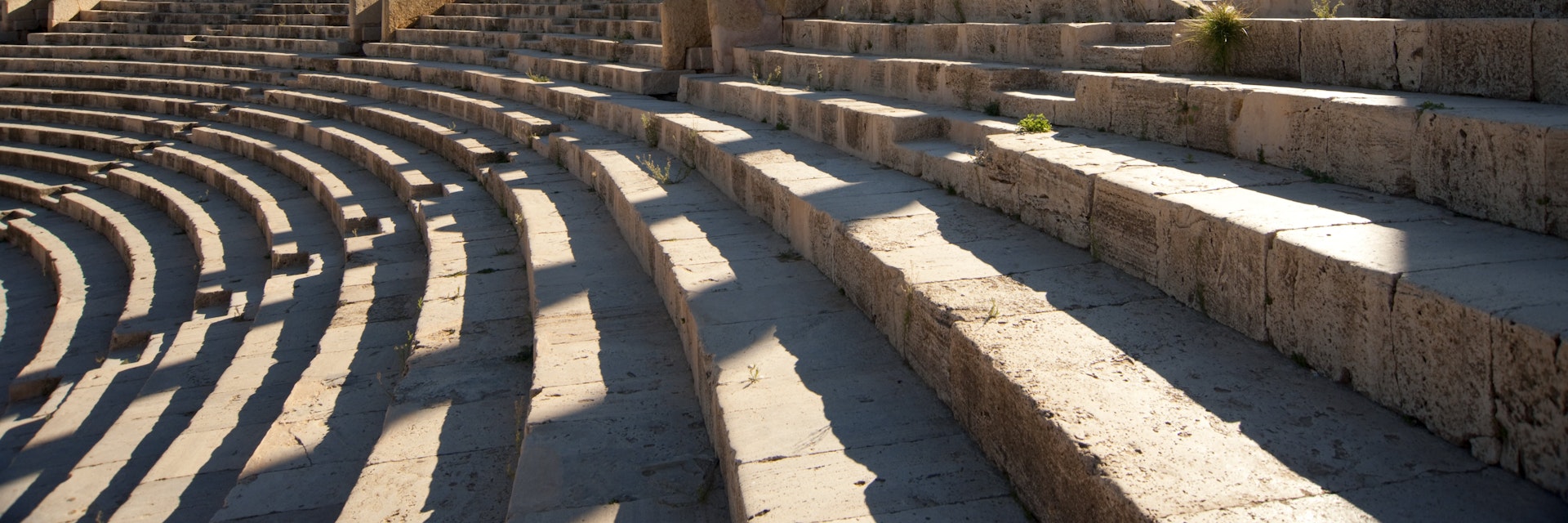
Pete Seaward
Libya is an ancient crossroads of civilizations that bequeathed to the Libyan coast some of the finest Roman and Greek ruins in existence, among them Leptis Magna, Cyrene and Sabratha. Libya also has some of the most beautiful corners of the Sahara Desert, from seas of sand the size of Switzerland and sheltering palm-fringed lakes (the Ubari Sand Sea) to remote massifs adorned with prehistoric rock art (the Jebel Acacus), labyrinthine caravan towns (Ghadames) and an isolated black-as-black volcano (Wawa al-Namus) in the desert's heart.
Your next trip starts here
Go from dreaming to planning with trip planning options made to help you craft your ideal itinerary.
Purchase our award-winning guidebooks
Get to the heart of Libya with one of our in-depth, award-winning guidebooks, covering maps, itineraries, and expert guidance.
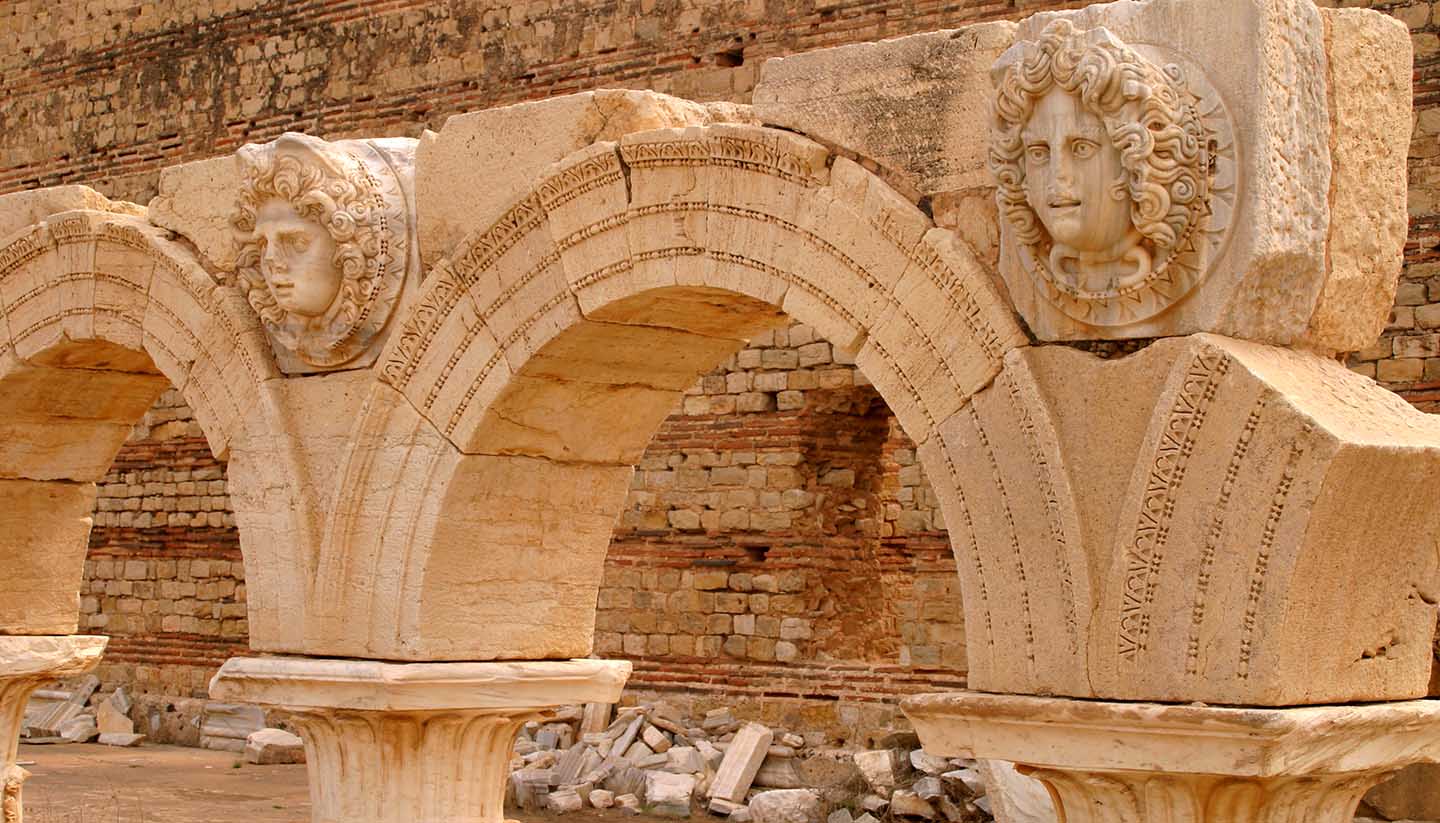
Introducing Libya
About libya.
- Images of Libya
- History, language & culture
- Weather & geography
- Doing business & staying in touch
Plan your trip
- Travel to Libya
- Where to stay
While you’re there
- Things to see & do
- Shopping & nightlife
- Food & drink
- Getting around
Before you go
- Passport & visa
- Public Holidays
- Money & duty free
Book your flights
Libya travel guide
Travel to Libya is ill-advised at the moment due to the ongoing civil war. And that’s a shame, because this beautiful land has much to offer the intrepid traveller.
One of the largest countries in African, Libya boasts a stunning Mediterranean coastline, gorgeous desert landscapes and no fewer than seven UNESCO World Heritage Sites. These ancient sites are a reminder that Libya’s history has always been tumultuous: before Gaddafi’s regime and the ensuing civil war, the country endured Greek, Roman and Italian rule.
But Libya has more to offer than war stories. From the mystical desert town of Ghadames to the stunning Sahara Desert, this is a land of empty beaches, ancient mountain trails and shimmering oases. It is a land where sand dunes stretch to the heavens, palm trees reflect in desert lakes and prehistoric rock carvings decorate the dramatic Akakus Mountains.
Rural Libya is characterised by neatly cultivated olive groves, fat lemons dangling from trees and remote Berber settlements. In the cities, merchants sell wares in rose-scented souks, flogging silver, spices, henna, hijabs and Tuareg scarves. The smell of spicy lentil soup and Benghazi seafood hangs deliciously in the air.
The population of Libya is mostly of Arab and Berber descent. Berbers make up about 10% of inhabitants and live in more remote areas. The rest of the population lives largely in coastal cities like Tripoli and Benghazi, although recent fighting has forced many to flee.
Libyan hospitality is legendary and its people love showing travellers around. But tourism faltered after the Arab Spring and has been paralyzed by the ensuing Civil War. At the time of writing, tourist visas were not being issued and most tour companies have closed their doors – many guides now work as fixers for war reporters instead.
It’s impossible to say how current events will pan out, but, like many travellers, we hope the doors to Libya will swing open again soon.
1,759,500 sq km (679,347 sq miles).
6,330,159 (UN estimate 2016).
3.6 per sq km.
Chairmen of the Presidential Council Muhammad Younes al-Menfi, since 2021.
Acting Prime Minister Osama Saad Hammad Saleh, since 2023.
Travel Advice
Your travel insurance could be invalidated if you travel against advice from the Foreign, Commonwealth & Development Office (FCDO).
FCDO advises against all travel to Libya
FCDO has advised against all travel to Libya since 2014. The local security situation is fragile and can quickly deteriorate, with intense fighting starting without warning. Any travel to, from or within Libya is at your own risk. If you are a British national in Libya, we strongly advise you to consider leaving.
Military activity in the region
On 13 April 2024 Iran carried out military action against Israel.
On 19 April, there have been reports of explosions in Iran, and unconfirmed reports of explosions in Syria and Iraq.
Monitor this travel advice and other media as the situation is changing fast. Follow and contact FCDO travel on Twitter , Facebook and Instagram . You can also get email notifications when this travel advice is updated.
Read FCDO advice on how to deal with a crisis overseas .
UK government support
UK government support is severely limited in Libya. The British Embassy in Tripoli does not provide support to British people who need help. If you are in Libya and need urgent help from the UK government (for example, if you’ve been attacked, arrested or someone has died) contact the British Embassy in Tunis, Tunisia , on +216 71 108 700 or contact us online .
Travel insurance
If you choose to travel, research your destinations and get appropriate travel insurance . Insurance should cover your itinerary, planned activities and expenses in an emergency.
About FCDO travel advice
FCDO provides advice about risks of travel to help British nationals make informed decisions. Find out more about FCDO travel advice .
Follow and contact FCDO travel on Twitter , Facebook and Instagram . You can also sign up to get email notifications when this travel advice is updated.
This information is for people travelling on a full ‘British citizen’ passport from the UK who choose to travel against FCDO advice. It is based on the UK government’s understanding of the current rules for the most common types of travel.
The authorities in Libya set and enforce entry rules. If you’re not sure how these requirements apply to you, contact the Libyan Embassy in the UK .
COVID-19 rules
There are no COVID-19 testing or vaccination requirements for travellers entering Libya.
Passport validity requirements
To enter Libya, your passport must be valid for the duration of your stay.
Check with your travel provider that your passport and other travel documents meet requirements. Renew your passport if you need to.
You will be denied entry if you do not have a valid travel document or try to use a passport that has been reported lost or stolen.
Previous travel to Israel
If your passport shows previous travel to Israel, it will not be accepted for travel to Libya.
Visa requirements
If you choose to travel to Libya against FCDO advice, ensure you have the right visa or you may be refused entry. Contact the Libyan Embassy in London for further information on the visa you require. You may require a specific type of visa depending on the nature of your trip.
A Libyan visa issued overseas may not be recognised in some areas or at certain ports of entry, due to the current political situation.
Vaccine requirements
For details about medical entry requirements and recommended vaccinations, see TravelHealthPro’s Libya guide .
Registering with the police
All short-stay visitors must register with the police within a week of arrival. The company you’re visiting or the local travel agency you’re using will usually arrange this. If you do not register, you could get a fine when you leave the country.
Customs rules
There are strict rules about goods you can take into or out of Libya . You must declare anything that may be prohibited or subject to tax or duty.
Taking money into or out of Libya
If you enter or leave Libya with over 10,000 US dollars-worth of cash, you must declare it to the customs authorities. If you do not, you risk having the money confiscated and even being detained.
There is a severe shortage of cash in Libya, and the Libyan Central Bank has imposed restrictions on cash withdrawals throughout the country.
Libya is a cash-based society. You cannot use bank cards at banks, ATMs or hotels.
The exchange of foreign currency into Libyan dinar is tightly controlled by the Libyan Central Bank. Accessing Libyan dinar through formal methods is difficult for travellers. You can legally use exchange offices approved by the Central Bank, but they operate at black market rates. No bank will change money. Informal methods of currency exchange exist though their use carries the risk of arrest.
It is illegal to take dinar out of Libya.
There is a high threat of terrorist attack globally affecting UK interests and British nationals, including from groups and individuals who view the UK and British nationals as targets. Stay aware of your surroundings at all times.
UK Counter Terrorism Policing has information and advice on staying safe abroad and what to do in the event of a terrorist attack. Find out how to reduce your risk from terrorism while abroad .
Terrorism in Libya
Terrorists are very likely to try and carry out attacks in Libya.
Attacks could be indiscriminate, including in places visited by foreigners. British people and nationals of other western countries are considered high-value hostages. Government buildings and security checkpoints have also been targeted in recent years, leading to deaths.
Extremist groups including Daesh in Libya (formerly referred to as ISIL) are responsible for most attacks, which have targeted:
- foreign and diplomatic personnel and premises
- international hotels
- oil installations
- government and other official security institutions
In 2021 Daesh claimed responsibility for 2 separate bomb attacks on Libyan security forces in the Fezzan province in southern Libya. These attacks killed at least 4 people.
While there is a greater concentration of terrorist groups in the Fezzan Province, it is highly likely smaller numbers of terrorists can move relatively freely to other towns and regions to facilitate activity outside of the Fezzan Province.
In the north of Libya, it is likely security pressure and violence between armed groups have helped to limit the movement of terrorist groups.
It is likely both Daesh and Al-Qaida in the Islamic Maghreb ( AQIM ) are using the Fezzan region in south-west Libya as a base for operations such as people-smuggling and illegally transporting weapons. These resources are essential to support terrorist activity in West Africa.
The risk of terrorism may be higher if you travel in the border regions. Extremist groups operating in the region, including AQIM and Daesh, conduct operations in the border areas of northern Mali, Niger and Algeria. They have a proven capability of travelling long distances to carry out attacks, including in neighbouring countries and Libya.
Terrorist kidnap
Terrorist groups including Daesh, Al-Qaida and their affiliates routinely use kidnapping as a tactic and can conduct kidnapping across borders. Terrorist groups within Libya have both intent and capability to carry out further kidnappings. It’s a realistic possibility that they will target foreign nationals. Criminal gangs also carry out kidnappings, and there is a realistic possibility that they would sell hostages on to terrorist groups. Foreign nationals have been kidnapped in Libya in the past, including 4 foreign nationals in south-east Libya in 2018.
It is likely that any kidnap for ransom attempt by a terrorist group in Libya would occur in the south of the country, whereas a kidnap for ransom by militias would occur in a northern coastal city.
There is a realistic possibility that a terrorist group, most likely Daesh-Libya or Al-Qaida in the Islamic Maghreb, will kidnap a western national in Libya. In recent months, the importance of oil and natural gas production in Libya has increased, and any western nationals working for oil and natural gas companies in Libya are highly likely viewed as high-value targets.
British nationals are seen as legitimate targets, including tourists, humanitarian aid workers, journalists and business travellers. If you are kidnapped, the reason for your presence is unlikely to protect you or secure your safe release.
The long-standing policy of the British government is to not make substantive concessions to hostage takers. The British government considers that paying ransoms and releasing prisoners builds the capability of terrorist groups and finances their activities. This can, in turn, increase the risk of further hostage-taking. The Terrorism Act (2000) makes payments to terrorists illegal.
Political situation
The political situation in Libya is fragile and the security situation remains dangerous and unpredictable.
There is a UN-facilitated ceasefire in place between eastern and western armed forces. The risk of renewed fighting between them has decreased, but there is still a high risk of localised violence between competing armed groups.
Violence between armed groups can break out with little warning. In 2022, clashes between armed groups in Tripoli killed 32 people and injured over 150. Clashes again broke out in August 2023 in central Tripoli, resulting in temporary roadblocks and Mitiga Airport closure. Tensions have since calmed, with roads now open and no further disruption to air travel from Tripoli’s Mitiga Airport.
Foreign forces and mercenaries continue to operate in Libya. The Interim Government of National Unity has limited control of security provision across the country. The lack of political stability has led to security incidents, road and airport closures, and oil blockades.
There have been protests throughout Libya against the continued political deadlock, lack of basic service provision and corruption.
If you choose to travel to Libya against FCDO advice, you should:
- monitor the local security situation carefully
- remain vigilant
- have robust security arrangements and contingency plans in place
Public infrastructure and services
Basic services across Libya vary. Petrol can be difficult to access and there are regularly long queues at fuel stations. There can also be power outages in Tripoli and the south and east, particularly in the summer months.
Crime is widespread across Libya and violent robbery, carjacking and smuggling of fuel, drugs, weapons and people are common across the country. Armed groups and local security services regularly carry out operations against criminal gangs.
Protecting your belongings
Take sensible precautions to protect yourself and your belongings. Foreign nationals may be a target for criminals operating in Libya. Be cautious when travelling throughout the country, particularly at night. You should:
- consider your route
- vary daily routines
- hide expensive looking items which could draw unwanted attention
British people have been detained by Libya’s intelligence services or armed groups. You are at higher risk of detention if you work:
- in private security
- as a journalist
If intelligence services or armed groups detain you in Libya, your health and welfare may be put at serious risk, especially if you have an existing medical condition. The British Embassy will have extremely limited capability to help you or intervene on your behalf. Any help will be even more limited for dual nationals of Libyan origin as you will be in your home country and dual nationality is not recognised by the Libyan authorities.
Laws and cultural differences
Personal id.
By law you must carry your passport. Foreign nationals have been arrested for failing to provide the correct documentation when requested.
Libya is an Islamic country. Always respect local traditions, laws and religious customs, especially during the holy month of Ramadan.
Ramadan dates vary by year and country. Ramadan next year is expected to start in March 2025.
During this time do not:
- eat, drink, smoke or chew gum in public in the daytime, including in your car
- play loud music or dance
- swear in public
Get more advice when you arrive from your hotel or business contacts.
You should also:
- check opening hours of shops and restaurants
- be aware that if hotels and restaurants are providing food or drink in fasting hours, they may separate you from Islamic guests, for example with screens
- follow local dress codes – clothing that does not meet local dress codes may cause more offence at this time
- be aware that fasting can cause tiredness, particularly during the later afternoon and early evening
- be patient and show tolerance
It is illegal in Libya to make any attempt to convert Muslims to another religion.
Alcohol and drugs laws
It is illegal in Libya to drink alcohol or use drugs. Libyan authorities treat drug and alcohol offences seriously. You can be punished for use, possession and trafficking of drugs or alcohol.
Business travel in Libya
There are often complex bureaucratic procedures needed to travel for work in Libya. Follow all relevant protocols and procedures if you intend to travel around Libya for business. You are likely to be at risk of intimidation, harassment and detention if you fail to comply with local customs.
Journalism in Libya
You must get press accreditation from the relevant government authorities. This may reduce the risk of harassment, intimidation and detention by armed groups and Libya’s intelligence services. There is a real risk of hostility from those who object to media reporting. International and local journalists have previously been detained in Libya.
Using cameras near military facilities
You must get permission before taking any photographs or interviewing at or near military facilities.
LGBT+ travellers
Same-sex sexual activity is illegal in Libya. Libyan society is intolerant of same-sex couples showing affection in public.
Read more advice for LGBT+ travellers .
Transport risks
Road travel.
Road travel within Libya remains highly dangerous. There is a risk of being caught up in outbreaks of localised violence between armed groups. There is a high risk of:
- striking unexploded bombs or mines off-road
The risk is very high on the coastal road between Zawiyah and Tripoli.
All land borders into Libya are subject to closure at short notice.
If the security situation worsens, routes in and out of major cities and towns may be blocked and airports closed or made inaccessible at little or no notice.
Do not share your travel or other plans through social media. Vary your travel routes and always keep a low profile.
Road traffic accidents are common and often result in deaths. The emergency response to a road traffic accident may be limited.
Flights to and from all airports in Libya are at risk of cancellation at short notice.
Tripoli International Airport has been closed since 2014, following clashes between armed groups in the area surrounding the airport. Other airports may change their flight schedule without notice. Mitiga Airport is Tripoli’s only currently functioning civilian airport. Fighting between armed groups in the area caused Mitiga Airport to temporarily close in 2023.
The UK Air Safety List (ASL) lists all known airlines in Libya that do not meet international safety standards and are banned from operating commercial air services to, from, and within the UK. Check the UK Air Safety List when considering which airlines to fly with. The list is maintained by the Department for Transport, based on advice from the UK Civil Aviation Authority .
Extreme weather and natural disasters
Storm damage in eastern libya.
In September 2023 Storm Daniel struck eastern Libya, causing severe flooding and significantly damaging critical infrastructure, including hospitals and telecommunications networks.
Before you travel check that:
- your destination can provide the healthcare you may need
- you have appropriate travel insurance for local treatment or unexpected medical evacuation
This is particularly important if you have a health condition or are pregnant.
Emergency medical number
Call 1415 and ask for an ambulance.
Medical help in remote areas may not be available. Even if your travel or insurance company has arrangements with an international air ambulance provider, they may not be allowed to carry out a rescue operation within Libya. The current status of Libyan rescue services is uncertain.
Contact your insurance company quickly if you’re referred to a medical facility for treatment.
Vaccine recommendations and health risks
At least 8 weeks before your trip:
- check the latest vaccine recommendations for Libya
- see where to get vaccines and whether you have to pay on the NHS travel vaccinations page
See what health risks you’ll face in Libya , including:
- leishmaniasis
- Rift Valley fever
- West Nile virus
- schistosomiasis
The legal status and regulation of some medicines prescribed or bought in the UK can be different in other countries.
Read best practice when travelling with medicines on TravelHealthPro .
The NHS has information on whether you can take your medicine abroad .
Healthcare in Libya
Healthcare in Libya is generally below the standard available in the UK. There are acute shortages of skilled personnel and medical supplies, particularly for chronic conditions such as diabetes. There are private clinics in Tripoli.
If you need treatment you may be evacuated to Malta or mainland Europe. Make sure you have adequate travel health insurance and accessible funds to cover the cost of any medical treatment abroad and repatriation.
Travel and mental health
Read FCDO guidance on travel and mental health . There is also mental health guidance on TravelHealthPro .
The Foreign, Commonwealth & Development Office ( FCDO ) cannot provide tailored advice for individual trips. Read this travel advice and carry out your own research before deciding whether to travel.
Emergency services in Libya
Telephone: 1415 (ambulance, fire, police)
Contact your travel provider and insurer
Contact your travel provider and your insurer if you are involved in a serious incident or emergency abroad. They will tell you if they can help and what you need to do.
Refunds and changes to travel
For refunds or changes to travel, contact your travel provider. You may also be able to make a claim through insurance. However, insurers usually require you to talk to your travel provider first.
Find out more about changing or cancelling travel plans , including:
- where to get advice if you are in a dispute with a provider
- how to access previous versions of travel advice to support a claim
Support from FCDO
FCDO has guidance on staying safe and what to do if you need help or support abroad, including:
- getting help if you’re a victim of crime
- what to do if you’re in hospital
- if you’re affected by a crisis , such as a terrorist attack
Contacting FCDO
You can also contact FCDO online .
Help abroad in an emergency
If you are in Libya and you need emergency help from the UK government, contact the British Embassy in Tunis, Tunisia , who provide consular assistance for Libya.
FCDO in London
You can call FCDO in London if you need urgent help because something has happened to a friend or relative abroad.
Telephone: 020 7008 5000 (24 hours)
Find out about call charges

Book a Hotel
© Columbus Travel Media Ltd. All rights reserved 2024
- 3 Other destinations
- 4.1 Politics and government
- 4.2 Geography
- 4.3.1 Ancient history
- 4.3.2 Italian colonial era
- 4.3.3 Kingdom of Libya
- 4.3.4 Libya under Muammar al-Gaddafi
- 4.3.5 Present history
- 4.4 Religion
- 4.5 Climate
- 5.1.1 Tourism requirements
- 5.1.2 Entry bans
- 5.1.3 Special requirements
- 5.2 By plane
- 5.3 By train
- 5.4.1 From Niger
- 5.4.2 From Chad
- 5.4.3 From Sudan
- 5.6 By boat
- 6.1 By plane
- 6.2 By road
- 10.2 Economy
- 16.2 Political unrest
- 16.3 Extreme weather
- 16.4 Road safety
- 16.5 Terrorism
- 16.6 Libyan dual nationals
- 16.7 Women travellers
- 16.8 LGBT travellers
- 16.9 Photography
- 17 Stay healthy
- 18.1 Home etiquette
- 18.2.1 Politics
- 18.2.2 Religion
- 20.1 Consular services
- 20.2.1 News outlets
Libya ( Arabic : ليبيا, Libiya ) is a country in the Maghreb region of North Africa and a part of the Arab world. Although the country is rich in history and culture and has great tourism potential, the country has been in the news for all the wrong reasons since the 1960s. Since the 2010s, the country has been in a state of flux and is rather dangerous to travel to.
However, under less extreme circumstances, this vast country has a lot to offer to the adventurous, thrill-seeking traveller, from deserts to historical ruins from various historical periods. Libya is a difficult country to get around, but the rewards for the persistent visitor are unforgettable.
If you do decide to visit, know that there's a lot to do and see in Libya; in fact, you might be showered with a lot of hospitality and care, even if you unintentionally make a few cultural blunders.
Regions [ edit ]

Cities [ edit ]
- 32.87519 13.18746 1 Tripoli (طرابلس) — the capital and largest city of Libya. The traveller's main entry point.
- 32.116667 20.066667 2 Benghazi (بنغازي) — the largest city of Cyrenaica and the second largest of the country
- 30.133333 9.5 3 Ghadamis (غدامس) — an oasis town with a large Berber population. The old part of the town is a UNESCO World Heritage Site.
- 27.033333 14.433333 4 Sabha (سبها) — an oasis city approximately 640 km (400 mi) south of Tripoli
- 32.827778 21.862222 5 Shahhat (شحات) — Ancient city of Cyrene, a World Heritage site , is nearby
- 31.2 16.6 6 Sirte (سِرْت) — the birthplace of Muammar Gaddafi, Libya's longtime ruler.
- 32.083333 23.95 7 Tobruk (طبرق) — harbour town with World War II cemeteries
- 32.933333 12.083333 8 Zuwara (زوارة) — a port city in the northwest not far from the Tunisian border
- 32.377778 15.090139 9 Misrata (مصراتة) — Libya's commercial hub
Other destinations [ edit ]
- 26.803056 13.535278 1 Gaberoun — small former Bedouin village on a wonderful oasis, around 150 km west of Sabha
- 24.961111 10.175 2 Ghat — an ancient settlement in the south west with prehistoric rock paintings and very challenging desert trekking
- Green Mountain
- 32.638332 14.290496 3 Leptis Magna — extensive Roman ruins
- Nafusa mountains
- 32.79335 12.48845 4 Sabratha – a UNESCO World Heritage Site on the Mediterranean coast in northwestern Libya.
Understand [ edit ]
Politics and government [ edit ].
Libya is officially known as the State of Libya ( Arabic : دولة ليبيا; Dawlat Libiya ).
Until 2011, the country was known as the Great Socialist People's Libyan Arab Jamahiriya ( Arabic : الجماهيرية العربية الليبية الشعبية الإشتراكية العظمى; al-Jamāhīrīyah al-'Arabīyah al-Lībīyah ash-Sha'bīyah al-Ishtirākīyah al-'Uẓmá ).
Geography [ edit ]
Libya is a large, vast, colossal desert nation, covering nearly 1,800,000 square kilometres (690,000 sq mi) of land. This makes it the world's 16th-largest country and Africa's 4th-largest country. Libya is slightly larger than Alaska , the largest state of the United States of America and nearly 160 times larger than Gambia , the smallest country in Africa.
Libya has a population of nearly 7 million people, making it one of the most sparsely populated countries in the world. While the country's northern parts are densely populated, the southern parts are virtually barren and uninhabited.
History [ edit ]
Ancient history [ edit ].
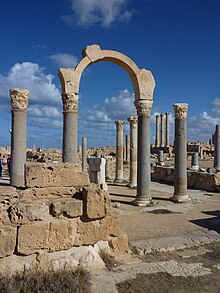
Archaeological evidence indicates that from as early as 8,000 BC, the coastal plain of Ancient Libya was inhabited by a Neolithic people, the Berbers, who were skilled in the domestication of cattle and the cultivation of crops. Later, the area known in modern times as Libya was also occupied by a series of other peoples, with the Phoenicians, Carthaginians, Greeks, Persian Empire, Romans, Vandals, Arabs, Turks and Byzantines ruling all or part of the area.
Italian colonial era [ edit ]
From 1912 to 1927, the territory of Libya was known as Italian North Africa. From 1927 to 1934, the territory was split into two colonies, Italian Cyrenaica and Italian Tripolitania, run by Italian governors. During the Italian colonial period, between 20% and 50% of the Libyan population died in the struggle for independence, and some 150,000 Italians settled in Libya, constituting roughly one-fifth of the total population.
In 1934, Italy adopted the name "Libya" (used by the Greeks for all of North Africa, except Egypt) as the name of the colony (made up of the three provinces of Cyrenaica, Tripolitania and Fezzan). King Idris I, Emir of Cyrenaica, led Libyan resistance to Italian occupation between the two world wars. Following Allied victories against the Italians and Germans, Tripolitania and Cyrenaica were under British administration, from 1943 to 1951, while the French controlled Fezzan. In 1944, Idris returned from exile in Cairo but declined to resume permanent residence in Cyrenaica until the removal of some aspects of foreign control in 1947. Under the terms of the 1947 peace treaty with the Allies, Italy relinquished all claims to Libya.
Kingdom of Libya [ edit ]
After gaining independence from Italy in the 1950s, Libya became a constitutional monarchy headed by King Idris. Under his reign, Libya espoused a pro-Western foreign policy and forged close ties with the United States and the United Kingdom . Libya's first-ever university was established in Tripoli , and Libya became a member state of the United Nations and the Arab League.
The discovery of large oil reserves in 1959 brought considerable wealth to the country and enabled Libya to transition to a wealthy country from one of the world's poorest countries. However, much of the oil wealth fell into the hands of Idris' inner circle, which strengthened negative sentiments towards the Libyan monarchy.
Libya under Muammar al-Gaddafi [ edit ]
By the 1960s, the Libyan monarchy became increasingly unpopular. More and more Libyans grew convinced that the Libyan monarchy was highly corrupt, inefficient at governing the country effectively, and weak. The rise of pan-Arab nationalism in the Middle East also contributed to negative sentiments towards the Libyan monarchy.
On September 1, 1969, a group of military officers led by Muammar Gaddafi − who was 27 years old and a captain in the Libyan army at the time − overthrew King Idris in a bloodless coup d’état. Having taken power, Gaddafi abolished the monarchy, kicked out Western military bases, deported the country's Italian population, and proclaimed the new Libyan Arab Republic , which was a military dictatorship in disguise.
In the late 1970s, Libya became known as the Socialist People's Libyan Arab Jamahiriya and Gaddafi styled himself as the 'Brotherly Leader and Guide of the Revolution'. This was a significant change, as it marked Libya's transition from a republic to an Islamic socialist state based on Gaddafi's personal political beliefs and philosophies.
The Gaddafi regime made a host of reforms, directing funds toward providing education, healthcare and housing for all, passing laws of equality of the sexes, criminalising child marriage and insisting on wage parity, although it also brutally put down all signs of dissent and promoted a cult of personality. Per capita income in the country rose to the fifth highest in Africa. Gaddafi engaged in support of, as he put it, "anti-imperialist and anti-colonial movements". During the 1980s and 1990s, Libya supported rebel movements such as ANC , PLO and the Polisario .
In early 2011, as part of the Arab Spring that attempted to turn the Arab countries into liberal democracies, the authority of the Libyan Arab Jamahiriya government was challenged by protesters, leading to a civil war, where NATO-led forces intervened with air strikes, military training and material support to the rebels.
On 20 October 2011 Muammar Gaddafi was killed by elements of the National Transition Council following his capture on a roadside in his hometown of Sirte. On 23 October the liberation of Libya was pronounced by the National Transition Council.
Present history [ edit ]
After 2011, Libya soon entered a civil war due to the disputes between the several armed groups that gained power during the insurrection. In September 2012, an attack of the Ansar al-Shariah extremist group on the U.S. embassy resulted in the death of the American ambassador and other public officers. In April 2016, U.S. president Barack Obama said that failing to prepare Libya for the aftermath of the ousting of Gaddafi was "the worst mistake of his presidency".
Libya remains deeply politically and economically unstable. Until March 2021, there were two rival governments: the Government of National Accord (internationally recognised), based in Tripoli , which controlled most of the West of the country, and the Council of Representatives, based in Tobruk , which controlled most of the east. These two governments, however, had limited control over the territory, a large part of it being effectively ruled by tribal warlords and extremist groups such as ISIS and Ansar al-Shariah.
A ceasefire took effect in October 2020, and the Government of National Unity assumed power from the rival governments. The main groups agreed to elections being held on 24 Dec 2021, but the elections have been delayed, as of May 2022 to the end of 2022.
There are hundreds of thousands of displaced people and food shortages are commonplace. Slavery has also made a return since the ousting of Gaddafi, with numerous slave markets now operating openly in various parts of the country.
Religion [ edit ]
Islam is the dominant religion in the country, practised by approximately 97% of the population. Most Libyans are Sunni Muslims.
Christianity is the second largest religion in the country, practised by approximately 2.7% of the population. Most Christians are followers of the Coptic Church.
Buddhism is practised by 0.3% of the population and it is believed that Libya has the largest Buddhist population in North Africa .
At some point in history, Libya was home to one of the oldest Jewish communities in the world and it is believed that Judaism came to Libya sometime during 400–300 BC. During World War II and the Gaddafi years, many Libyan Jews fled the country in search of a better life elsewhere.
Climate [ edit ]
Within Libya as many as five different climatic zones have been recognised, but the dominant climatic influences are Mediterranean and Saharan. In most of the coastal lowland, the climate is Mediterranean, with warm summers and mild winters. Rainfall is scanty. The weather is cooler in the highlands, and frosts occur at maximum elevations. In the desert interior the climate has very hot summers and extreme diurnal temperature ranges.
Get in [ edit ]

Entry requirements [ edit ]
Libya is a very difficult country to access, mainly because its immigration requirements are notoriously perplexing. The Libyan government has a history of changing its immigration rules frequently and without warning.
Everyone, except citizens Jordan and Tunisia , requires a visa to enter the country.
Tourism requirements [ edit ]
Visitors travelling to Libya for tourism are required to convert US$1,000 , or equivalent, in freely convertible cash or debit the amount from a valid credit card upon arrival. Failure to do so will result in you being denied entry. There are, however, a few exceptions to this rule:
- Those travelling as part of a guided tour.
- Those who have been sponsored by a Libyan citizen.
Entry bans [ edit ]
Citizens of Israel , Bangladesh , Iran , Pakistan , Yemen , Sudan and Syria are banned from entering Libya.
- The Libyan government appears to be convinced that Bangladeshi citizens regularly abuse Libyan immigration rules just so that they can emigrate to Europe from Libya.
- The Libyan government appears to be convinced that Sudan and Syria are involved in "undermining" Libya’s security and sovereignty.
- The Libyan government appears to be convinced that Iranian , Yemeni , and Pakistani citizens often join Islamic terror groups.
- Due to the Arab-League boycott of Israel, citizens of Israel and those who have visited Israel are forbidden from entering the country.
Special requirements [ edit ]
If you are a citizen of the United States , you are required to be sponsored by a Libyan company before coming to Libya.
By plane [ edit ]
Most visitors normally enter Libya by plane.
Ever since the civil war began, air operations have become quite unreliable as airports are repeatedly closed and opened again depending on the level of violence in the area.
The Benina International Airport , ( BEN IATA ), ( Arabic : مطار بنينة الدولي) is in the town of Benina, 19 km east of Benghazi .
Libya has several other airports, but many of them may remain closed:
- Bayda , La Abraq Airport—( LAQ IATA )
- Ghadames , Ghadames Airport—( LTD IATA )
- Ghat , Ghat Airport—( GHT IATA )
- Al Jawf , Kufra Airport—( AKF IATA )
- Sabha , Sabha Airport—( SEB IATA )
- Sirte , Gardabya Airport—( SRX IATA )
- Tobruk , Tobruk Airport—( TOB IATA )
- Ubari , Ubari Airport—( QUB IATA )
By train [ edit ]

There have been no operational railways in Libya since 1965. There are plans to establish an extensive rail network, but work on it has been halted due to the fluid security and political situation.
By car [ edit ]
Libya shares borders with six countries: Algeria , Tunisia , Egypt , Chad , Niger , and Sudan .
For travel to Libya overland, there are bus and "shared taxi" (accommodating 6 people in a station wagon) services from such places as Tunis , Alexandria , Cairo and Djerba .
There are accounts of people having done the trip in their own 4x4s or using their own dirt bikes and campervans. There are very few border posts open to travel into the country with a foreign car: Ras Jdayr (from Tunisia) and Bay of As Sallum (from Egypt). At the border, you must buy a temporary licence including a number plate.
From Niger [ edit ]
The Libya-Niger border is often described as an "ungoverned area", i.e, a region with limited government presence. Moreover, areas near the Libya-Niger border are hotspots for terrorism, human trafficking, smuggling, and organised crime. Given Libya's proximity to Europe, many migrants from Niger often try to sneak in.
If you have no knowledge of Libyan roads, Nigerien roads, or both and if you have no experience with driving in harsh climates, you should not drive into Libya from Niger.
From Chad [ edit ]
Areas near the Libya-Chad border are hotspots for terrorism, militancy, human trafficking, smuggling, and organised crime. In addition to these issues, relations between Chad and Libya are incredibly unhealthy and the Libyan authorities often close the Libyan-Chadian border without prior warning.
From Sudan [ edit ]
Given the poor security and political situation in Sudan , travelling overland from Sudan to Libya is not recommended.
By bus [ edit ]
There are bus services from Tunisia and Egypt .
Previous scheduled services may take an extended time to restore, please ensure your travel is through a stable area before boarding any service .
By boat [ edit ]
Supposedly, in 2023, there is a ferry, the Kevalay Queen, connecting Tripoli and Misrata with Istanbul.
Previous scheduled services may take an extended time to restore, please check before ticketing for any service .
Get around [ edit ]

Due to the immense size of the country, the terrible state of the roads, and the poor security situation, the only way to get around the country quickly is by plane. This is not to say that it's entirely safe, but it's still a better alternative to travelling overland.
By road [ edit ]
Prior to the civil war many visitors undertook the trip in their own 4x4s or using their own dirt bikes and campervans. It would seem that they encountered considerable hospitality once in the country. It was not uncommon to see convoys of European campervans on Libya's highways prior to the civil war. Please make serious and detailed enquiries prior to undertaking any trip by road into Libya to determine if the area you will be travelling through is safe and if fuel and other services are available. Travel such as this is not recommended.
Some self-drive car rental services are available in the large cities but the rates were typically high and the cars unreliable. Avis and Europcar provide rental cars. Around the major cities, driving can be an "education", although driving standards are not as bad as in other countries in the region.
The recommended method of transport for tourists around major towns is taxis. There are also many shared taxis and buses. The small black and white taxis (or death pandas) tend to be safer (more cautious drivers) but learn the term "Shweyah-Shweyah", Libyan for slow-down, and ask them to keep off Al-Sareyah (the motorway from Souq-Al-Thataltha to Janzour)! A taxi driver will routinely try it on with tourists. Will always try to charge 10 dinars for a fare around town. Negotiate the price first. If you find a good taxi driver with a good car, it doesn't hurt to build up a relationship and get their mobile number. Taxis from the airport can be more expensive as the airport is a long way from town. The Corinthia Hotel runs a shuttle from the airport to the hotel.
Longer journeys such as Tripoli to Benghazi will take about 14 hours by bus. The buses make stops for meals and the very important tea (shahee) breaks along the way. A faster method is to take the "shared taxis" but some of the drivers tend to be more reckless in order to cut the travel time. Services such as inter-city bus services have been seriously disrupted or halted due to the civil unrest and armed conflict. Travel by long distance bus services in Libya is not recommended.
If travelling by road in post liberation Libya very high levels of situational awareness should be practised at all times. Fuel supplies and vehicle repair services may be disrupted and some roads and bridges may be damaged. Armed groups and dis-affected individuals, armed militias and detachments of foreign military and military contractors are active throughout Libya. The opportunity to inadvertently become involved in a violent confrontation or robbery is much higher than in many other countries in the region and caution should be exercised. If in doubt stop and take cover or if possible immediately depart the area to a safer location.
Talk [ edit ]
The official language of Libya is Arabic .
The local vernacular is Libyan Arabic . It has extensive borrowings from languages such as Italian, Turkish, and Amazigh/Tamazight ("Berber"). For instance, the word for traffic light is "semaforo" and the word for petrol is "benzina". Modern Standard Arabic is rarely spoken in everyday conversations. However, most Libyans are knowledgeable in MSA, so if you wish to improve your Arabic skills, you shouldn't have any problems. You're not expected to know the local dialect, but if you make an attempt to learn a few words of the local vernacular, you will impress the locals!
English is the most widely taught foreign language in Libyan schools and it is widely used in commerce. You should not have problems getting around using only English, but the downside of speaking English is that you'll immediately be identified as an outsider and may attract unwanted attention from some undesirable people (e.g. criminals, corrupt officials). Outside of Tripoli , however, English is probably rarely used.
Although Libya was once an Italian colony, the use of Italian has diminished drastically since independence. Very few people (apart from the elderly, the well-educated, members of the Italian community, and businesspeople) nowadays speak Italian.
See [ edit ]

Libya's colourful capital Tripoli makes for a great start to explore the country, as it still has its traditional walled medina to explore, as well as the interesting Red Castle Museum , with expositions on all parts of the region's history. Despite the development as a tourist destination, this remains a quintessentially North-African place, with a range of beautiful mosques and impressive fountains and statues to remind of its historic role in the great Ottoman Empire. Some 130 km from the capital is Leptis Magna (' Arabic : لَبْدَة), once a prominent city of the Roman Empire. Its ruins are located in Al Khums, on the coast where the Wadi Lebda meets the sea. The site is one of the most spectacular and unspoiled Roman ruins in the Mediterranean. Another must-see is Cyrene , an ancient colony founded in 630 BC as a settlement of Greeks from the Greek island of Theraand. It was then a Roman city in the time of Sulla (c. 85 BC) and now an archaeological site near the village of present-day Shahhat and Albayda .

The vast Sahara makes for some excellent natural experiences, complete with picture-perfect oases like Ubari . The Unesco listed town of Ghadames was once a Phoenician trade town, and the ruins of its ancient theatre, church and temples are a major attraction today. For stunning landscapes, try the Acacus Mountains , a desert mountain range with sand dunes and impressive ravines. The varied cave paintings of animals and men that were found here have earned the area recognition as a UNESCO World Heritage Site too.
Do [ edit ]
Buy [ edit ], money [ edit ].
The Libyan currency is the Libyan dinar , denoted by the symbol " ل.د " or " LD " (ISO code: LYD ). The dinar is subdivided into 1000 dirhams. Banknotes are issued in denominations of 1, 5, 10, 20, and 50 dinars. Coins are issued in denominations of 50, 100 dirhams, ¼, and ½ dinar.
The Libyan dinar is commonly called jni in the (western Libyan Dialect) or jneh in the eastern Libyan dialect. These terms are derived from the "guinea", a former unit of currency in the UK. The word dirham is not used in everyday speech. Garsh is used instead to refer to 10 dirhams.
ATM cards are widely used in Tripoli more other areas and most big name stores and some coffee lounges accept major cards. Check that your card is going to work before leaving major centres as previous networks and ATM facilities may be damaged or missing.
Economy [ edit ]
The Libyan economy during the Gaddafi era depended primarily upon revenues from the oil sector, which contributed about 95% of export earnings, about one-quarter of GDP, and 60% of public sector wages. Substantial revenues from the energy sector, coupled with a small population, gave Libya one of the highest per capita GDPs in Africa. Libyan Arab Jamahiriya officials made progress on economic reforms in last four years of their administration as part of a broader campaign to reintegrate the country into the international fold. This effort picked up steam after UN sanctions were lifted in September 2003 and as Libya announced that it would abandon programs to build weapons of mass destruction in December 2003. Almost all US unilateral sanctions against Libya were lifted in April 2004, helping Libya attract more foreign direct investment, mostly in the energy sector. Libya applied for World Trade Organization membership, reduced some subsidies and announced plans for some privatisation of state-owned companies. The former Libyan government invested heavily in African projects including large scale telecommunications and other major international infrastructure and development programs. Sanctions were re-applied in 2001.
In 2011 actions by domestic insurgents and foreign military forces effectively closed down the normal functions of civil administration during the civil war period.
Eat [ edit ]

In Tripoli, it is surprisingly hard to find a traditional Libyan restaurant. Most serve western-style cuisine, with a few Moroccan and Lebanese restaurants thrown in. There are also good Turkish restaurants, and some of the best coffee and gelato outside of Italy. There are some wonderful Libyan dishes you should taste in case you are fortunate enough to be invited to a Libyan dinner party or wedding (be prepared to be overfed!)
A favourite café for the local expatriate community is the fish restaurant in the souq. For the equivalent of a few US dollars, you can enjoy a great seafood couscous. A local speciality is the stuffed calamari.
Also recommend Al-Saraya: Food OK, but its attraction is its position, right in Martyr's Square (Gaddafi name: Green Square). Another good seafood restaurant is Al-Morgan, next to the Algiers Mosque, near 1st of September Street.
There are flashy looking big fast-food outlets in Tripoli. These are not quite the multinationals, but a close copy of them. They are springing up in the Gargaresh Road area, a big shopping area in the western suburbs of Tripoli.
Try one of the best local catch fish named "werata" grilled or baked with local herbs and spices.
Drink [ edit ]
Tea is the most common drink in Libya. Green tea and "red" tea are served almost everywhere from small cups, usually sweetened. Mint is sometimes mixed in with the tea, especially after meals.
Coffee is traditionally served Turkish style: strong, from small cups, no cream. Most coffee shops in the larger cities have espresso machines that will make espresso, cappuccino, and such. Quality varies, so ask locals for the best one around.
Alcohol is banned in Libya, though it is readily available through a local black market (anything from whisky to beer to wine). Penalties for unlawful purchase can be quite stiff.
Sleep [ edit ]
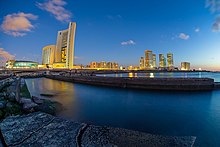
Major cities have a range of accommodations available, from shabby hotels to 4-star establishments. Prices vary accordingly.
In Tripoli, there are a couple of international-standard hotels: the Radisson Blu opened in 2009/2010 and offer excellent accommodations and services, while the older Corinthia Hotel, is located adjacent to the old city ( The Medina or "Al Souq Al Qadeem" ). Other hotels are Bab-Al-Bahr, Al-Kabir, and El-Mahari.
Manara Hotel, a tidy 4-star hotel in Jabal Akhdir, east of Benghazi, is next to the ancient Greek ruins of Appolonia Port.
While it seems to be diminishing with the arrival of more tourists every year, Libyans have a strong tradition of taking travellers into their own homes and lavishing hospitality on them. This is certainly true in smaller towns and villages.
There are several good hotels in Tripoli's Dhahra area, near the church like Marhaba hotel.
Youth Hostels , associated with the IYH Federation (HI), are available. Please contact the Libyan Youth Hostel Association, ☏ +218 21 4445171 .
Learn [ edit ]
Learn more about Libya's UNESCO World Heritage Sites [1] .
Work [ edit ]

Finding a job in Libya is not an easy endeavour, even for Libyan nationals themselves. There are not enough jobs for everyone (Libya's unemployment is between 20-30%) and this forces many Libyans to work abroad in other countries. As is the case in every other country, you must have a work permit if you want to work in the country.
Although the government welcomes investment and help, excessive bureaucracy, high levels of corruption, and political instability mean that many are often reluctant to take up work opportunities in the country. Also, without any knowledge of Arabic, adapting to life in Libya may become a bit challenging. Keep all this in mind if you wish to work in Libya.
Libyan authorities take abuse of Libyan immigration laws very seriously ; in 2015, the country outright banned Bangladeshi citizens from entering the country because many Bangladeshi citizens (reportedly) came to the country just to illegally migrate to Europe.
If you have a background in construction, you might be able to find a job in the country's construction sector and be a part of the country's rebuilding efforts. For a country that has been ravaged by open warfare for a decade, much of the country's infrastructure is in desperate need of repair.
Some international organisations, such as the United Nations, are situated in Tripoli . If you have a background in politics or international relations, working in the country won't be such a bad idea. In addition, the country is a great place to further develop your Arabic language skills and make a difference in a country torn apart by years of conflict and instability.
Stay safe [ edit ]
The security situation in Libya is fragile and unpredictable . Although some have been brave enough to enter and leave the country without any difficulties, anything can happen in this politically unstable nation.
Crime [ edit ]
Libya has a very high crime rate thanks to years of warfare and instability. Law and order is virtually non-existent in large parts of the country. Foreign visitors are likely to be seen as "easy targets" by Libyan criminals and are likely to be detained for all kinds of reasons.
Don't flash or exhibit objects like cameras, mobile phones, laptops, and so on in public, don't be too trusting of people you don't know, and be aware of your surroundings at all times. In the unlikely event you are robbed, do not fight back, or else you might end up being dragged into a violent fight.
The Libyan justice system is horribly corrupt, fragmented, and inefficient; therefore, if you are the victim of a crime, do not expect the courts to readily prosecute prepetrators and do not expect Libyan law enforcement to take you seriously.
Political unrest [ edit ]
The political situation in the country is far from stable .
The first ever presidential election, which has been repeatedly postponed since December 2018, is likely to heighten existing tensions throughout the country. What exactly will happen is open to interpretation.
It is strongly recommended that you regularly monitor local media; you never know what can happen.
Extreme weather [ edit ]
Libya is dominated by the hot, warm, dry Saharan desert; temperatures can rise as high as 50 degrees Celsius. Be sure to hydrate often and wear appropriate clothing to deal with the heat.
Road safety [ edit ]

Driving by most Libyans is wild , and much of the country's road network is poorly developed and maintained. Drivers attack their art with an equal mix of aggressiveness and incompetence. Traffic laws are rarely enforced, and the country has a high road accident rate.
Since much of Libya is covered in vast deserts, wind-blown sand can reduce visibility without warning. In addition, highway signs are usually in Arabic, and roadside assistance is limited. If you don't know Arabic and have no experience with driving in North Africa , it would be better not to drive in Libya.
Terrorism [ edit ]
As obvious as it sounds, no part of Libya should be considered entirely safe; the potential for violent incidents, either targeted or random, exists anywhere at any time, and many governments advise that terrorists are likely to conduct attacks in Libya.
Libyan dual nationals [ edit ]

If you are considered Libyan – such as having a Libyan father or being born to a Libyan parent – by the authorities, possessing another passport will not grant you consular assistance or protection.
Women travellers [ edit ]
If you are married to a Libyan, you are subject to Libyan marital laws : your children cannot leave the country unless your (former) husband gives permission. This may make it impossible for you to leave the country with your children if you decide to divorce your Libyan husband.
If you had the misfortune of being married to an abusive spouse and are not prepared to deal with the prospect of never seeing your children again, encourage them to not go in the first place.
LGBT travellers [ edit ]
As is the case throughout the Arab world and the Middle East , homosexuality is frowned upon by the vast majority of Libyans. Open display of such orientations may result in open contempt and possible violence.
Under current laws, same-sex activity is punishable by up to 5 years in prison. This law, in practice, is rarely enforced because militias may choose to execute LGBT people instead. There are no laws and policies in place that protect the rights of members of the LGBT community.
Photography [ edit ]
Libya has strict rules about taking pictures. For example, photographing or filming military or law enforcement personnel or installations is a quick way to get into trouble.

Stay healthy [ edit ]
Prior to the fall of the Libyan Arab Jamahiriya, Libya had an excellent health care system. However, the civil wars that soon followed badly damaged and devastated the once excellent health care system. Many hospitals are in a state of despair and there's a shortage of medical supplies and staff.
Good quality healthcare facilities can be found in major cities such as Tripoli .
Medical care in the most remote parts of Libya is virtually non-existent.
Even if you have travel health insurance it may not be valid in the country. It's advisable to check in advance with your insurer.
Respect [ edit ]
Much of what is considered good manners in the Arab world is applicable to Libya.
Libyans are indirect communicators . They are tempered by the need to save face and protect their honour and they will avoid saying anything that could be construed as judgemental or negative. One's point is expressed in a roundabout way.
Never beckon a Libyan person directly , even if they've done something wrong in your opinion. Libyans in general are non-confrontational by nature and can be rather sensitive to strong, harsh comments. Under Libyan law, if you are thought to have defamed someone or violated the honour or reputation of someone, you can be taken to court. What exactly counts as "defamation" and "violating someone's honour" is open-ended and subjective, but simply put, refrain from making strong comments about people, even if your perspective happens to be true.
Respect for elders is important in Libya. You are expected to act politely around someone older than you, and it would be seen as rude manners if you attempt to challenge someone older than you. It's commonly expected for the senior-most person to make decisions in the business world. If you come across someone who is older than you, give up your seat on public transportation for them. If you're waiting for a taxi, allow someone older to take your spot. If you're in a business meeting, stand up to greet the senior person. If you've been invited to a Libyan home, greet the elders first.
Libyans take relationships very seriously and they view them as long-term commitments. In the business world, Libyans prefer to do business with those they know and respect and look for long-term relationships.
Always use your right hand when shaking hands, bringing something to someone, and so on. The left hand is considered unclean in Libya. It would be considered impolite to use your left hand to offer something to someone, and it would be seen as awkward to eat with your left hand.
The pace of life in Libya is quite slow . Building relationships and getting things done require you to demonstrate sincere interest as Libyans try to do things in a measured, careful manner. Do not express frustration at this or try to rush things; it can be seen as insulting.
Home etiquette [ edit ]
- Libyans are not known for being punctual, which can be very surprising to visitors from countries where punctuality is highly valued. Lateness does not imply rudeness or a lack of interest; people have a casual approach to time.
- If you've been invited to a Libyan home, you will often be showered with tea, coffee, and snacks. Refusing any of these would offend your hosts and it could get them to think that you do not appreciate them or their hospitality.
- You'll often be encouraged by your hosts to take second helpings ad infinitum. If so, take it as a form of respect as it may leave a good impression on your hosts.
- Utensils are not used when eating. People tend to eat with their right hands. As is the case in many Muslim-majority countries, the left hand is considered unclean.
Things to avoid [ edit ]
Politics [ edit ].
- It is illegal to criticise the country, the state flag, or the state emblem. Doing so is punishable by up to three years of imprisonment. You do not have to praise the country excessively; just be polite. It is also a crime to criticise another country's flag or state emblem on Libyan soil.
- Criticism of the government is unacceptable in any way, shape, or form. Under current Libyan laws, you can be arrested for "insulting" or "disparaging the dignity of" public officials. You never know who you might be talking to. For similar reasons, don't engage in political discussions with people who bring up politics. Again, what exactly constitutes as "insulting" and "disparaging someone's dignity" is open-ended and subjective, but simply put, be careful with divulging your opinions on the country's political situation. Those who have left Libya may be more open to having a political discussion.
- As is the case throughout the Arab world, the Israel-Palestine conflict can be a dicey and highly emotive topic for some people. Unless you have a heart for prolonged discussions, avoid discussions on Israel.
- Avoid having a discussion on Muammar Gaddafi . In some circles, people feel that there was more stability under his rule and may be offended by negative comments about him or his regime. Gaddafi loyalism is still strong in cities like Sirte .
- Islam is the dominant religion in Libya and it plays an important role in the lives of many. During Ramadan , you should refrain from eating, drinking, smoking, and chewing in public.
- It is illegal to criticise or speak badly about Islam. Doing so is punishable by up to two years of imprisonment.
- It is illegal to proselytise any religion other than Islam. This includes possessing religious literature.
Connect [ edit ]
Cope [ edit ], consular services [ edit ].
Due to various factors − the effects of the civil war, the ongoing humanitarian crisis, the volatile security situation, political instability, and so on − many embassies and consulates offer limited services. Some governments have closed down their diplomatic missions completely.
Most embassies, foreign missions, and provisional offices are situated in Tripoli ; some consulates can be found in Benghazi .
If requiring assistance from your nation's consular representatives, it may be possible to seek them out in a country adjoining Libya or from a partnered government if a citizen of an EU state. Australia refers their citizens to the Australian embassy in Rome , while Canada and the United States of America refer their citizens to their embassies in Tunis .
Media [ edit ]
Libya has numerous newspapers, radio stations, podcasts, and magazines.
News outlets [ edit ]
- Libyan News Agency . The state news agency of the Libyan Government. Published in Arabic, English, and French.
- Has custom banner
- Has warning box
- Has map markers
- Has VisaRestriction box
- Has VisaRestriction box with no date
- Has caution box
- Has caution box with no date
- Has warning box with no date
- Outline countries
- Outline articles
- Country articles
- North Africa
- All destination articles
- Has Geo parameter
- Pages with maps
Navigation menu
This website stores cookies on your computer. These cookies are used to collect information about how you interact with our website and allow us to remember you. We use this information in order to improve and customize your browsing experience and for analytics and metrics about our visitors both on this website and other media. To find out more about the cookies we use, see our Cookies Policy .
If you decline, your information won’t be tracked when you visit this website. A single cookie will be used in your browser to remember your preference not to be tracked.
Libya Tourism Statistics
Libya ly: international tourism: expenditures, view libya's libya ly: international tourism: expenditures from 1995 to 2013 in the chart:.
Libya LY: International Tourism: Expenditures: % of Total Imports
View libya's libya ly: international tourism: expenditures: % of total imports from 1995 to 2013 in the chart:.
Libya LY: International Tourism: Expenditures: for Passenger Transport Items
View libya's libya ly: international tourism: expenditures: for passenger transport items from 1995 to 2013 in the chart:.
Libya LY: International Tourism: Expenditures: for Travel Items
View libya's libya ly: international tourism: expenditures: for travel items from 1995 to 2013 in the chart:.
Libya LY: International Tourism: Number of Arrivals
View libya's libya ly: international tourism: number of arrivals from 2004 to 2008 in the chart:.
Libya LY: International Tourism: Receipts
View libya's libya ly: international tourism: receipts from 1995 to 2010 in the chart:.
Libya LY: International Tourism: Receipts: % of Total Exports
View libya's libya ly: international tourism: receipts: % of total exports from 1995 to 2010 in the chart:.
Libya LY: International Tourism: Receipts: for Passenger Transport Items
View libya's libya ly: international tourism: receipts: for passenger transport items from 1995 to 2013 in the chart:.
Libya LY: International Tourism: Receipts: for Travel Items
View libya's libya ly: international tourism: receipts: for travel items from 1995 to 2010 in the chart:.
Explore our Data

Home » Travel Guides » Libya » 15 Best Places to Visit in Libya
15 Best Places to Visit in Libya
There’s no question about it: Libya is in turmoil. Since the popular uprisings of the Arab Spring in 2011 and following more than 40 years of iron-fist rule by one Muammar Gaddafi, the country has hardly emerged well. Today, civil war and factional disputes still rage across the nation, extremism is rife, and much of the old beauty lies in ruins. But all wars must end, and hopes that Libya will one day return once again to the tourist fold remain very much alive.
So, FCO warnings and travel bans of today notwithstanding, we look to the future with optimism: to a time when this great slab of the old Maghreb can showcase its glorious Roman ruins and crumbing Greek cities; when the energy of metropolises like Tripoli and Benghazi can wow travelers; when the rugged Mediterranean coastline can shine and shimmer; and when the deep Islamic cultures and histories of the place can peak through in the dusty medinas and Bedouin camel towns alike.
Lets explore the best places to visit in Libya :

Before the tumult of the civil war and the rising of the Arab spring, Tripoli was a poster boy for North African heritage.
Its winding labyrinth of backstreets melded the warmth and colours of the Med with the dusty and historic character of the Sahel.
Street vendors touted spice-covered, ghee-doused bazins from the roadside stalls; teahouses throbbed with the mellifluous tones of Arabic chatter and the twisting fumes of shisha pipes.
And at the center of town visitors would find the grand Assaraya al-Hamra, spilling itself into the tight-knit lanes of the medina in a medley of mosque minarets and formidable Ottoman towers.
2. Leptis Magna

Founded by the Phoenician Greeks sometime in the first millennium BC, and then raised to greatness by the Romans, who flocked to this coastal spot in western Syria to secure their strongholds in North Africa after the Carthage Wars, Leptis Magna is quite possibly the single most impressive ancient site in the country (sorry Cyrene!). While some sections of the old temples and peristyles here have been transferred to museums and parks in England, the majestic likes of the grand theatre, arches dedicated to Septimius Severus, the fortification walls, some early Roman basilicas, and the crumbling marketplace all still remain.
3. Benghazi

Much-ravaged Benghazi has had its fair share of troubles in Libya’s wars.
And while the city continues to rattle in the throes of factional trouble, it is trying to shake of the memory of those hard-fought battles during the campaigns of 2011 and 2012, and re-establish itself again as one of the principle port towns in North Africa.
Glimmers of the glorious past still remain too, like the elegant whitewashed homes of the Italian Quarter, the sun-kissed corniche called Lungomare on the Med (palm-peppered and pretty), the old Latin lighthouse on the shore, and the picturesque Maydan al-Shajara square in the very center of city.

A legendary patchwork of temples and ancient townhouses that sits perched atop the Mediterranean cliffs in eastern Libya, Cyrene is one of the greatest relics the Greeks left in North Africa.
Once a booming mercantile colony built by the seafarers of Santorini, the city played host to Hellenic merchants, the heirs of Alexander the Great, and, later, Roman generals and armies.
Today it lies half in ruins; abandoned since it was rocked by a great earthquake in the 4th century AD. Visitors come to tour the colossal shrines to Demeter, see the necropolis, and explore the revered Sanctuary of Apollo.
5. Ghadames

Whitewashed homes scramble over one another in the heart of desert-shrouded Ghadames.
Meanwhile, winding alleyways hemmed in with adobe walls weave back and forth through the medina that forms the middle of the city – a UNESCO World Heritage Site in its own right.
Nestled between the sand dunes of the northern Sahara just a stone’s throw from the Algerian border, this earthy little Berber outpost is hailed as one of the real jewels of the nation’s backcountry.
Travelers come to explore its palm-peppered roads and shady terraces, and get a glimpse of the Libya that time forgot.

This far-flung town on the edge of the historic Fezzan region was once one of the principal trading points on the Sahara-Sahel caravan route.
Topped by its great mud-brick castle, Ghat still looks the part too, especially with all those crumbling old neighborhoods of adobe Berber homes spreading out from the base of the central mount.
However, the fortress seen today was not actually even there when the kings of the Garamantian Empire ruled the trade links between Carthage and the south in antiquity.
It was built later by the Italians and today, along with the rugged caves and cliffs of the Tadrart Acacus mountains, forms the major point of interest in the town.
7. Sabratha

Like Cyrene before it, Sabratha followed the predictable trajectory of a onetime Greek colony on the North African coast.
First, it was a receptacle for Mediterranean goods coming southwards, and a marketplace for exotic African goods coming from sub-Sahara.
Later, the whole city was taken over by the Romans, who raised great temples to both local and imperial gods.
There are remnants of a Christian basilica built by Justinian too, along with the grand mosaics that once adorned the interior.
However, the piece de resistance is the ancient theatre, which erupts from the desert in a series of lurching Doric peristyles and arcades.

The birthplace of one Colonel Muammar Gaddafi has not fared well in Libya’s recent upheavals.
Targeted by the rebel forces and used by the loyalists for their last stand, hardly a single street went unscathed in the ensuing Battle of Sirte in 2011. It was here that the onetime leader of the nation was finally captured and killed, marking the end of his more than 40-year-long rule.
Today, other conflicts engulf the town, but efforts are being made to rebuilt and reconstruct the spot, which was once a colonial outpost of both the Ottomans and the Italians.

Like many cities in Libya, Tobruk has seen its fair share of carnage in the last 100 years.
However, Tobruk is best known as a battlefield of a different era: The Second World War.
During the early 1940s, this town was the site of some of the fiercest skirmishes between Allied and Axis troops in the region.
The ordeals were finally settled by the Second Battle of El Alamein.
In the modern era Tobruk remained steadfastly loyal to the Libyan monarchy, and was quick to rise with the tide of the Arab Spring.
Visitors will get to tour the site of these totemic events, and unravel tales of Greek, Roman and Berber history besides.
10. Misrata

Lining up along the shimmering Mediterranean coast, the 500,000-strong city of Misrata (also spelled Misratah) represents the third-largest in the country.
Founded by the Greeks (like so many towns in these parts), it grew into one of the principal trading ports in North Africa, with a booming harbour at Qasr Ahmad that dealt in both African and European goods.
Most visitors will come to enjoy the sun-kissed beaches that meld with the Saharan dunes to the east and west of town, while others will tour the great city mosques and the multi-cultural array of architecture that imbues the center.
11. Waw an Namus

Taking us away from Libya’s war-torn cityscapes and ancient sites for a spell of the weird and the wonderful, the black-stained tar and rock fields of Waw an Namus are a truly otherworldly sight to behold.
Set deep in the very heart of the Saharan Desert, the attraction is only just becoming popular with intrepid travelers.
They come to wonder at the great extinct volcanic cone that rises from the sands, its nearby crater lake (shining like a mirror and forever buzzing with a haze of mosquitoes), and the old caravan oases towns of Al Kufrah and Rebiana.
12. Msallata

Engulfed by swathes of olive plantations and undulating hills of scrub that roll out to meet the Med and the Sahara to the north and south respectively, it’s one of the prettier spots in the Murqub District.
Visitors to the town, which was the site of some violent clashes during the 2011 revolution, can come and wander rustic olive oil mills and farms.
There’s also a long history to uncover, as Msallata once hailed in as one of the major stop-overs on the way to ancient Leptis Magna during the heyday of Roman rule in these parts.
13. Al Jawf

Al Jawf is surrounded by the sweeping ochre sands at the very heart of the Libyan Sahara.
A small town, it’s largely made up of low-rise adobe homes and camel-dotted streets that come pot-holed and crooked.
And while there’s little to experience in the city itself apart from the earthy Bedouin character of the place, there’s plenty in the surrounding hinterland.
Yep, Al Jawf is the gateway to the Kufra basin; one of the most strategic agricultural areas in the region, famed for its irrigation capabilities and alien-looking crop circles.
This surrounding territory has been much fought over since time immemorial, just as relics like the crumbling 7th-century granaries at Gasr Al-Hajj reveal.

Below the rugged tips of the El-Bhallil mountains and peppered with surprisingly green spots of palm oases, the desert town of Waddan is a great place to come and catch a glimpse of the earthy backcountry character of Libya, and to unravel the deep Islamic histories that have coalesced here over the centuries.
Look up to see the crenulated walls of the great Waddan Castle, which were raised by the onetime Arab rulers of the Maghreb.
Then, be sure to take some time to wander the date palm groves and marketplaces, taking in the bucolic, time-stood-still vibes.

The lakeside city of Sabha is home to the striking bulwarks of Fortezza Margherita (now called just Fort Elena): one of the most dramatic and historic of citadels still standing in the country (it’s even depicted on the back of some Libyan banknotes!).
Above that, Sabha is also considered the best gateway to the Fezzan region, which rolls out to meet the Sahara Desert proper in a patchwork of date palm oases and undulating dunes from the southern edges of the town.
15 Best Places to Visit in Libya:
- Leptis Magna
- Waw an Namus
How to Travel to Libya in 2024
By Joan Torres 25 Comments Last updated on April 12, 2024
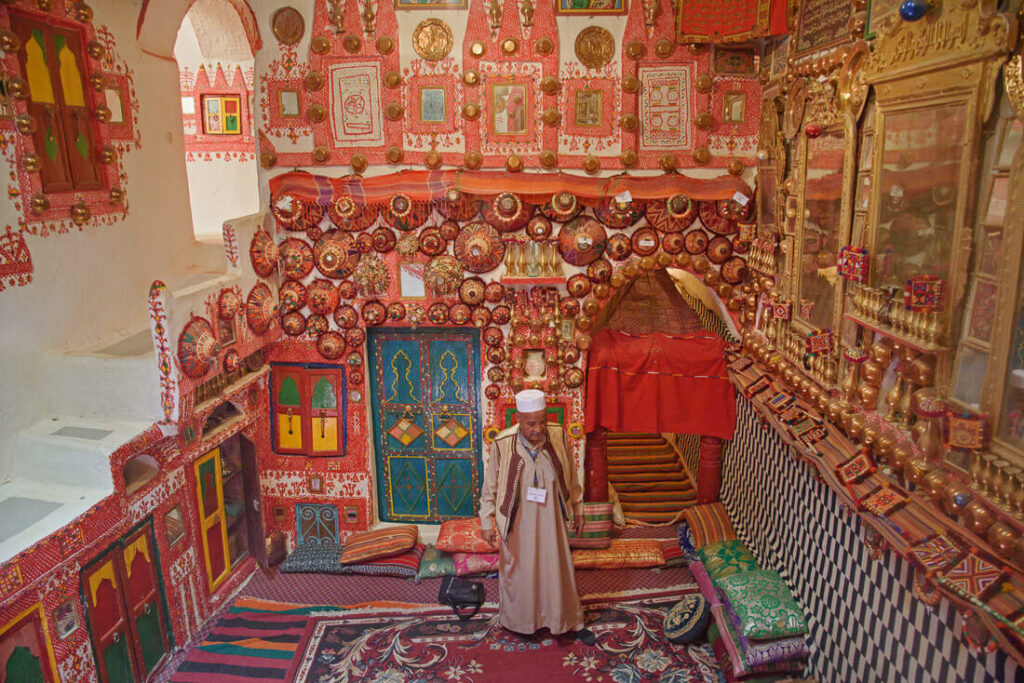
This is the most complete and up-to-date Libya travel guide available on the internet.
Libya is a surprising country indeed.
Home to Leptis Magna and Sabratha, Libya has outstanding, world-class Roman ruins, sitting on the Libyan coast.
From 1911 to 1951, the country was an Italian colony, the heritage of which is still very visible, not only in the architecture that dominates the center of Tripoli, but also in the somehow sophisticated way Libyans drink their cappuccino.
Except for a tiny part of the – today inaccessible – eastern coast, Libya is an utterly massive, barely populated desert, filled with ancient Berber, caravan towns like Gadhames, located more than 600km from Tripoli.
Today, however, Libya has become a failed state struggling to put an end to an armed conflict that has been ongoing since 2011, preventing travelers from venturing into the most off the beaten track country in the whole Mediterranean.
However, with proper planning and research, anyone can travel to Libya safely.
This guide contains endless Libya travel tips that will show you how.
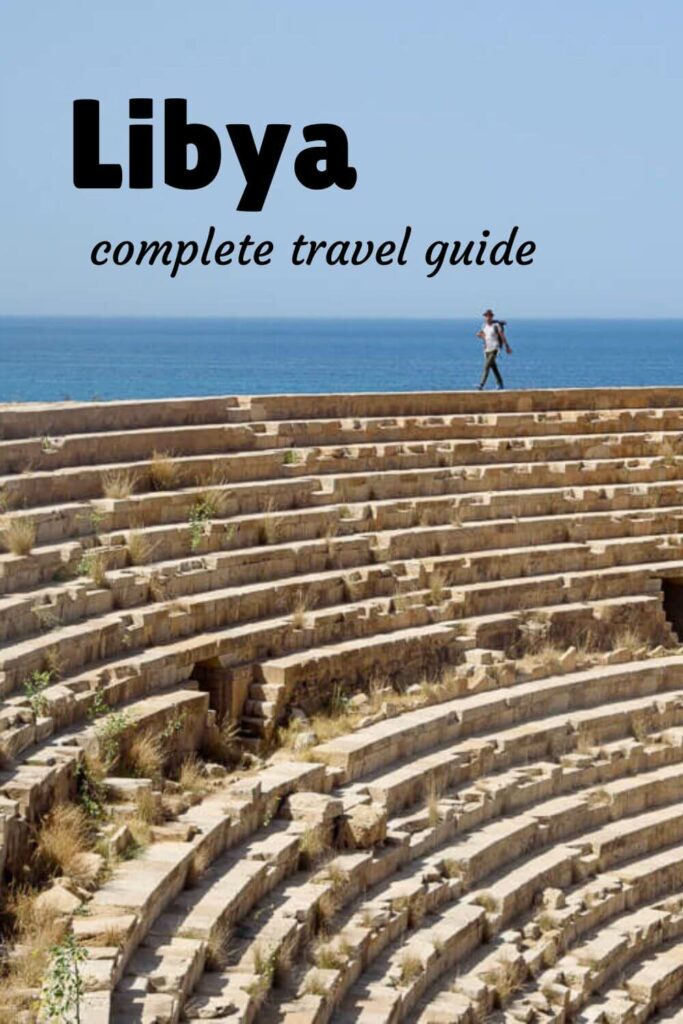
In this Libya travel guide, you’ll find:
Table of Contents
- Libya today
- How to get a visa
- Travel Insurance
- Independent travel in Libya
- Best time to visit
- Top experiences
- Internet & connectivity
- Budget & Money
- Getting around
- Libyan cuisine
- Where to stay
- Solo female travel
- More information
📰 Libya today: what is it like to travel to Libya?
In 2011, following the Arab Springs in neighbouring Tunisia and Egypt , a set of peaceful protests against an absolute Libyan dictator, Muammar Gaddafi, escalated into a bloody armed conflict between the rebels and Gaddafi’s local forces.
One year later, Gaddafi was defeated , captured, and killed, putting an end to more than 40 years of dictatorship.
For the first time ever, Libyans were able to foresee a bright, beautiful future but, unfortunately, the same people that wanted to overthrow Gaddafi, claiming to favor democracy, began to fight each other over power and wealth, dividing the country into different regions controlled by different militias.
A second civil war began, and on and off conflicts continued until the country officially split into two main regions, ruled by two different, independent Governments: West Libya, with Tripoli as the capital, and East Libya, with Benghazi as the main city.
However, in October 2020, exhausted from a pointless civil war, both Governments signed a permanent ceasefire and promised to hold elections, but they have been continuously postponed ever since.
Today, the peace agreement is still valid, but that doesn’t avoid the occasional clashes between the two Governments, and their permanent disagreements over power, like happened in May 2022 .
Tourists can travel to Libya now, but your visa will only be valid for traveling in the Western part of Libya because the Eastern Government doesn’t recognize it.
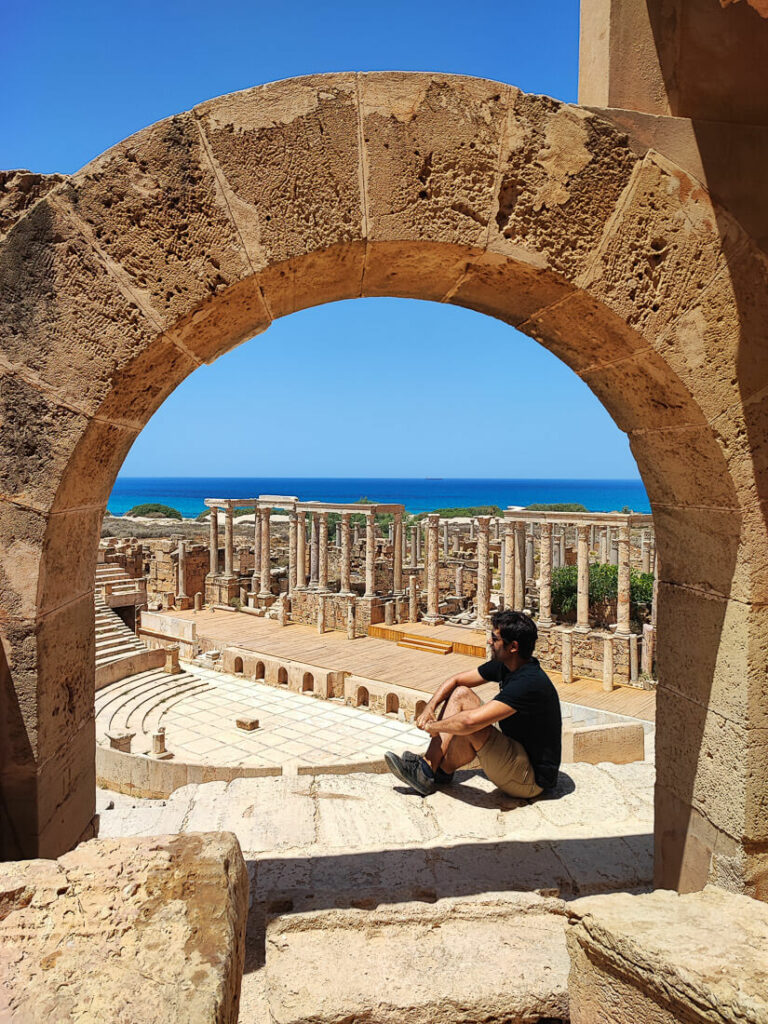
⚠️ Is it safe to travel to Libya?
By far, safety is the number 1 concern for people wanting to visit Libya, which is kind of understandable, since the media has been showing nothing but years and years of conflict.
As previously mentioned, a peace agreement was signed between both West and East Governments back in 2020 and, except for a few occasional clashes between the Government forces – where civilians are not targeted – traveling to the West part Libya is mostly safe nowadays.
All Libyans will tell you that today, traveling to Libya is completely safe and as long as the money coming from oil – Libya is an oil-rich country – keeps flowing through both East and West, it will remain so, or that’s what many locals Libyans believe.
My personal experience when I went to Libya
From Afghanistan to Syria and Iraq , one can really feel that you are in a conflict or post-war country but for some reason, not in Libya.
On the one hand, you barely see any military presence there, at least in the areas where you are allowed to travel, and that includes the capital too.
On the other hand, while destruction is prevalent in most Syrian cities’ skylines, Tripoli is pretty untouched, as were all the places we visited, except for the main avenue in Misrata, the city that suffered the most.
We saw a few buildings with bullet holes and stuff but not even 1% of what you see in Mosul or Aleppo .
Again, I just saw one tiny part of the country, and I know that in Benghazi, for example, there was a fierce battle but, from a traveling standpoint, most places in West Libya are intact, and the atmosphere seems surprisingly relaxed.

🪪 How to get a visa for Libya
Can you travel to Libya?
Libya is one of the most difficult countries to travel to but the local authorities are making things a bit easier now…
Up to September 2023 , only business visas were issued, so the Libyan company had to fake your purpose of travel, stating that you were visiting Libya as an oil or tourist consultant, something like that, but this is not the case anymore.
Now you can finally travel to Libya on a tourist visa, even though the visa process is pretty much the same.
Below is an explanation of how to get a visa for traveling in Libya.
Step 1 – Getting your Letter of Invitation (LOI)
In order to get your visa for Libya, the first thing you need to do is get a Letter of Invitation from an authorized Libya-based company.
Note that Libyan companies won’t issue an LOI unless you book a full tour of Libya with them.
How long do I have to wait to get the LOI?
The problem with Libya is that nothing is official.
They say that LOI are issued in 1 week but sometimes they don’t come until 3 weeks later and sometimes they in just 3 days.
Libya’s bureaucracy is so random.
How long is the LOI valid for?
There’s no official date but rumors say it has a 1-month validity, extendable to 3 months. Again, this is also pretty random.
Step 2 – Getting your actual visa at the embassy
Once your LOI is approved, the next step is visiting the Libyan embassy in your home country or country of residence.
The LOI will come with a 6-digit number, and it’s recommended to call the embassy in advance, telling them about your upcoming visit and the respective number.
I got my visa at the Libyan embassy in Madrid .
They told me to physically go there any day, from Monday to Wednesday, from 10am to 1pm, and these were their requirements:
- Passport with more than 6 months validity
- 2 passport photos
- Letter of Invitation
- Letter from the company you work for, stating the business reason you want to travel to Libya
Once they checked that all my documents were correct, they told me to deposit the amount of 60€ in their bank account – which I did at the nearest bank – and come back with the receipt.
When I gave them the receipt, they told me to come back after two hours to collect my visa, that’s it.
That’s for the embassy in Madrid, what about the rest of the embassies?
Requirements are pretty much the same across most embassies but, while some of them require the applicant to be physically there, others allow you to mail them all docs.
Moreover, like in Madrid, some embassies issue your visa within 2 hours, while others might take a few days.
The best way to find out is by calling your nearest embassy.
What if there’s no embassy in your home country?
Then, you can apply from an embassy of your choice, but you need to tell your local sponsor in advance.
How long is the visa valid for?
Up to September 2023, the visa was valid for 1 month, from the moment you collect it and it can’t be extended.
However, now they say that they will extend it to 3 months.
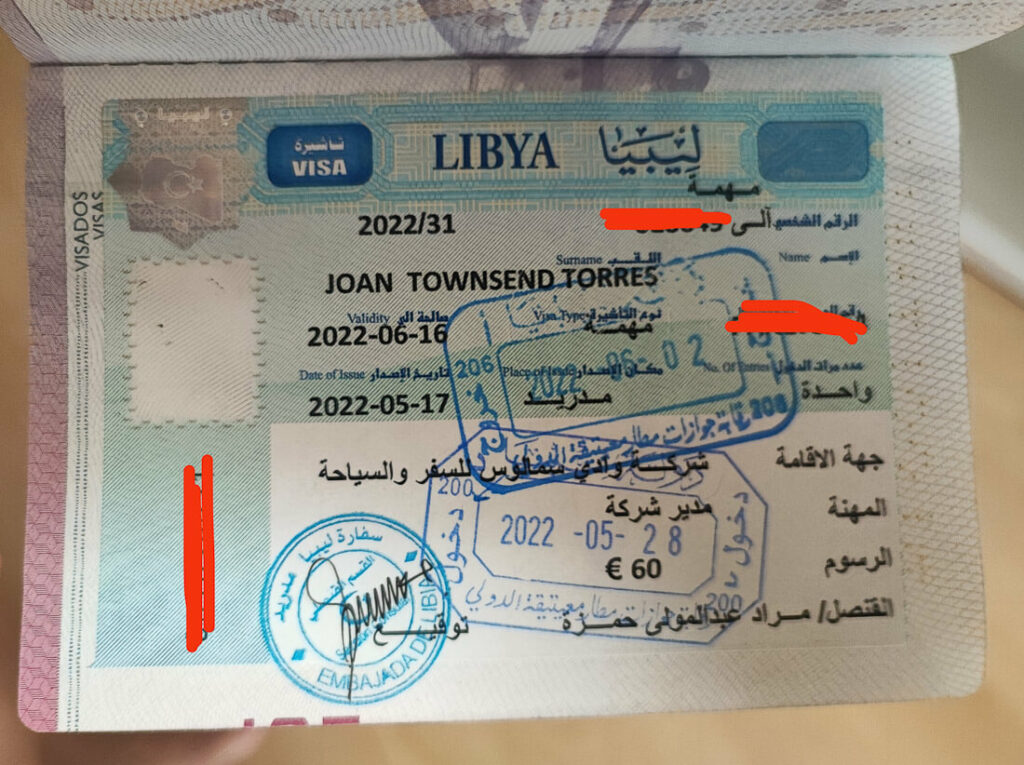
🚑 Travel insurance for Libya
Travel insurance for Libya is a real must, especially in times of pandemic, and I strongly recommend IATI Insurance because:
- One of the very few that covers travel in Libya
- They have many different plans, for all budgets.
- Covers both short-term trips and 1-year long trips.
- It covers senior citizens too
- Readers of this blog can get a 5% exclusive discount
🧔 Traveling to Libya as an independent traveler: is it allowed?
Not really.
Actually, independent travel in Libya has never been totally allowed, even during Gaddafi’s rule, and the reason is that, in their eyes, foreigners could always be potential spies.
Today, in order to get the above business visa, you’ll have to book a tour with a tour company, so there isn’t a way around, plus here are a few things to keep in mind:
Your local guide must pick you up from immigration
Nowadays, upon arrival at the International Airport of Tripoli, even before getting your entry stamp, the authorities will put you aside, waiting for your sponsor, a representative from the company who issued your LOI – the local guide, in my case.
This person will have to go through a few formalities and only then, will you be able to enter Libya.
You will be accompanied by a local official
During my trip to Libya, I had always to be accompanied by an official who claimed to be part of the tourist police.
Along with my local guide and driver, this person stuck with us the whole time, eating with us and even staying in our hotels outside of Tripoli.
While spending the whole trip with an official might seem quite annoying – you actually have to pay for his meals and hotels – but that’s included in the total tour package – the truth is that he was a pretty nice guy who basically became one more of us.
He was unarmed, joked all the time and always tried to be helpful.
Some travelers who travel to Libya as gas consultants (fake purpose, of course) claim that they were never accompanied by such an official, but only the local guide.
Your itinerary can’t be flexible
It can’t be changed. Your itinerary will be shared with the security department before your arrival and making changes won’t be allowed.
Can you walk around Tripoli on your own
Officially you can’t but in practice, many travelers do it: this is something you must discuss with your local guide.
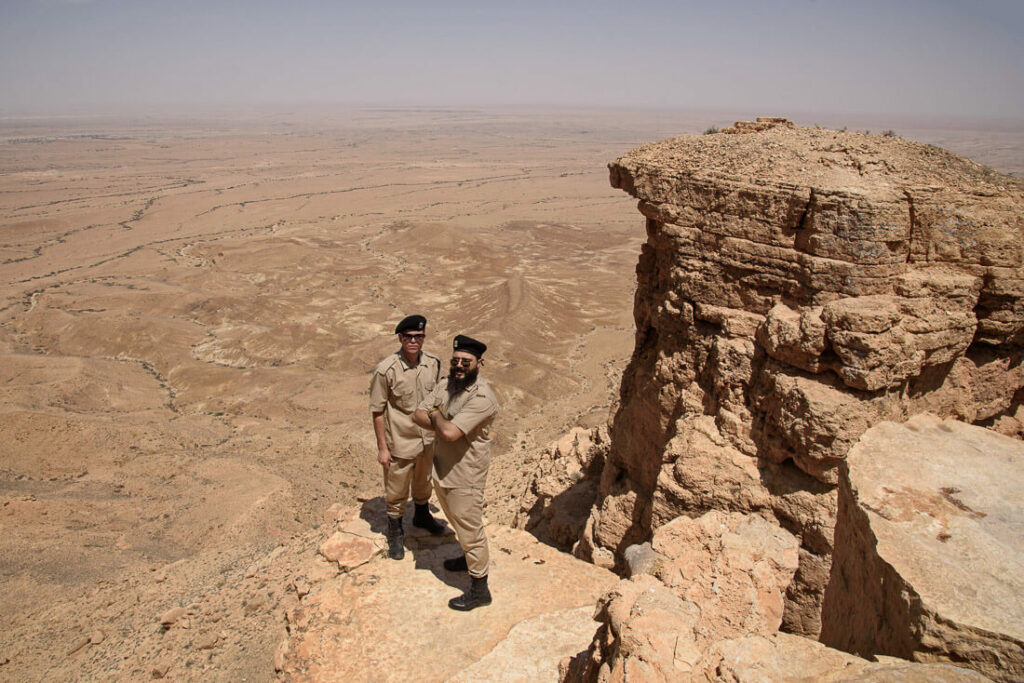
🗺️Tours for Libya
Remember that independent travel in Libya is not possible nowadays, like no way.
Against the Compass, however, has several scheduled expeditions.
Epic 7-day expeditions, where we will explore Roman ruins, caravan cities and learn about everything that happened after the fall of Gaddafi.
Learn more about our Tours for Libya
Do you wish to join a small group, but you can’t travel on any of the above dates?
No problem, just shoot me an email ([email protected]) indicating:
- How many people you are
- How many days do you want to spend in Libya
- Which dates
And we will try to find other travel buddies you may travel with. Otherwise, know that we can also organize private, tailored trips.
⛅ Best time to visit Libya
Best time to travel to libya: november to march.
The weather becomes pleasant during these months but note that temperature can drop to 0ºC in December-January, so do bring warm clothing for the freezing nights, especially in the desert areas.
Worst time to travel to Libya: June to September
In summer, Libya is too hot to enjoy.
I personally came during the last week of May and days were already utterly hot, making sightseeing very difficult. Evenings however, were good.
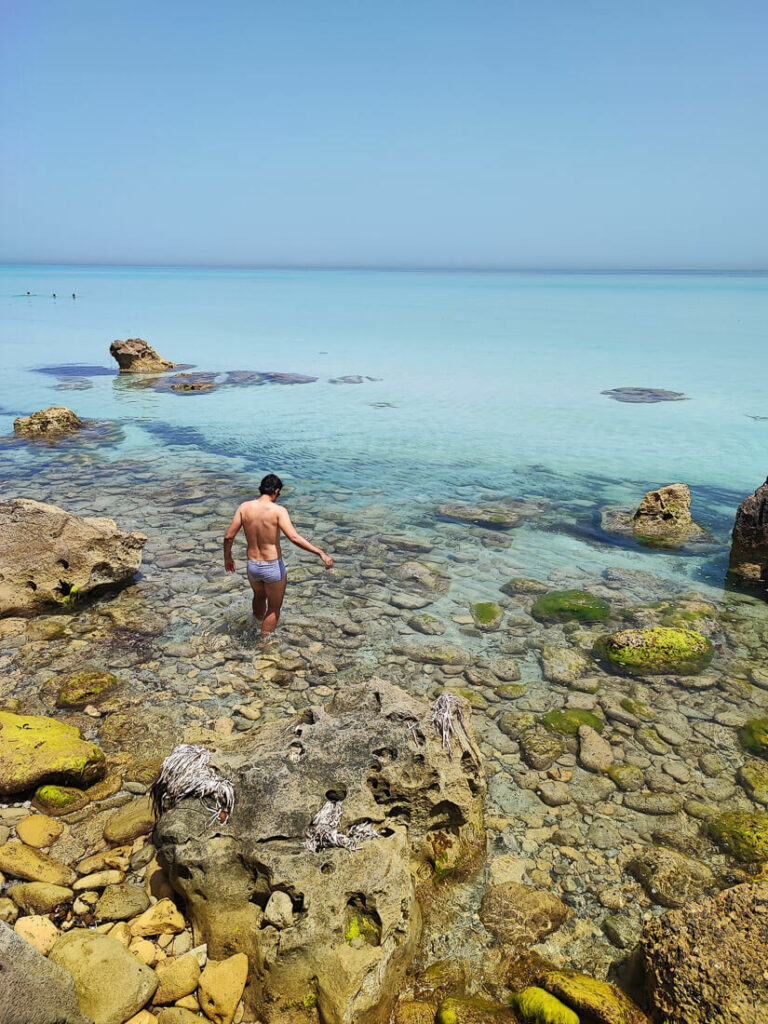
🛫 How to get to Libya
Insurance for traveling to Libya I strongly recommend IATI Insurance : Full Libya coverage + 5% discount BUY IT HERE TO GET YOUR SPECIAL DISCOUNT
How to travel to Libya by air
The main airport in Libya is Mitiga International Airport , located 11km from the center of Tripoli.
This airport used to have plenty of connections but nowadays, you can only travel from two cities:
I strongly recommend coming from Tunis, since flights are way cheaper.
Which airlines fly to Libya?
Today, the only foreign airline that flies to Tripoli is Tunis Air but the problem is that it doesn’t fly there every day, only 2-3 times a week, so depending on your travel dates, it could be inconvenient.
Alternatively, Libyan Wings flies from Tunis to Tripoli every day but the problem is that you can’t book tickets online, so someone has to go to an actual Libyan Wings office and pay in cash. This is something you’ll need to arrange with your local guide or sponsor .
How to travel to Libya by land:
Libya shares a border with 5 countries.
Traveling to Libya from Tunisia
Travel reports suggest the border is open, and there are actually direct buses from Tunis to Tripoli but, besides the nearly 800km distance, border formalities will take a lot of time if you go on a bus packed with people.
Alternatively, you could head slowly to the border (the one by the coast) and cross on foot. However, if you opt for this choice, your local guide will have to pick you up from there, increasing the overall cost of your trip.
Check my Tunisia travel guide
Traveling to Libya from Egypt
This border used to be open during Gaddafi’s time but not anymore, since the Eastern part of Libya is controlled by a different faction that won’t recognize your business visa.
Check my Egypt travel guide
Traveling to Libya from Algeria, Niger, Chad and Sudan
Those borders are super closed.
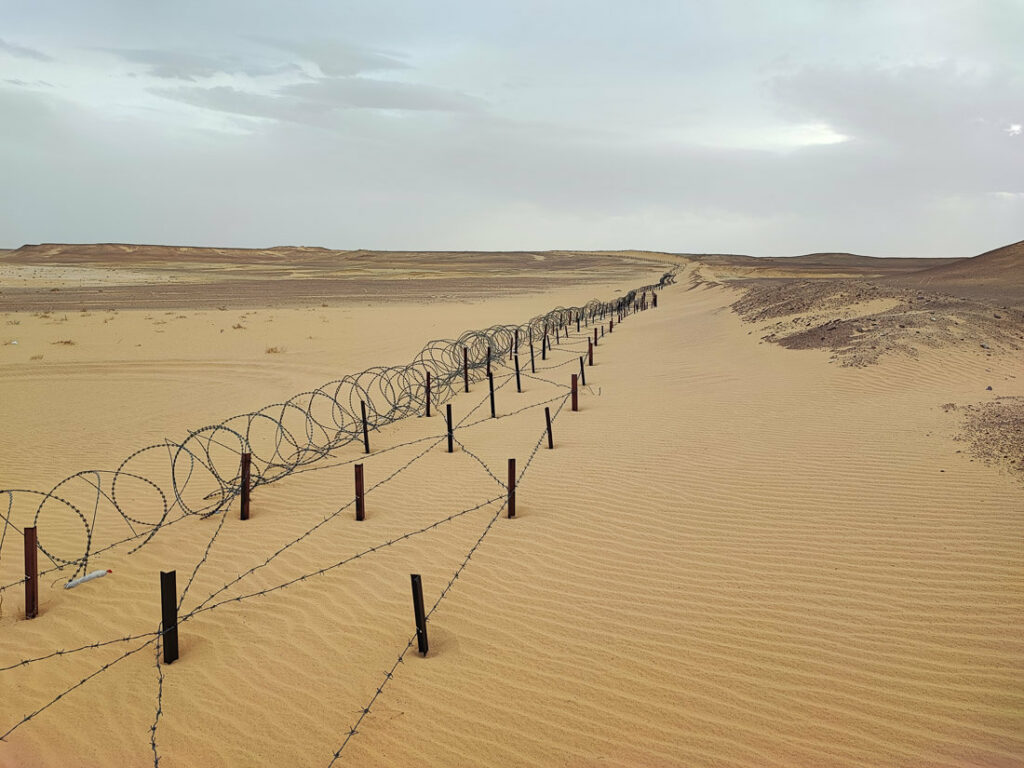
🛖 Top experiences in Libya
Libya has actually a lot of touristic potential; it is no wonder that during the Gaddafi years, many tour groups used to come here.
1 – Visiting first-league Roman ruins
Leptis Magna and Sabratha are exceptional Roman sites, with no reason to envy Palmyra in Syria , or Baalbek in Lebanon , and the best thing about them is that they are built by the sea.
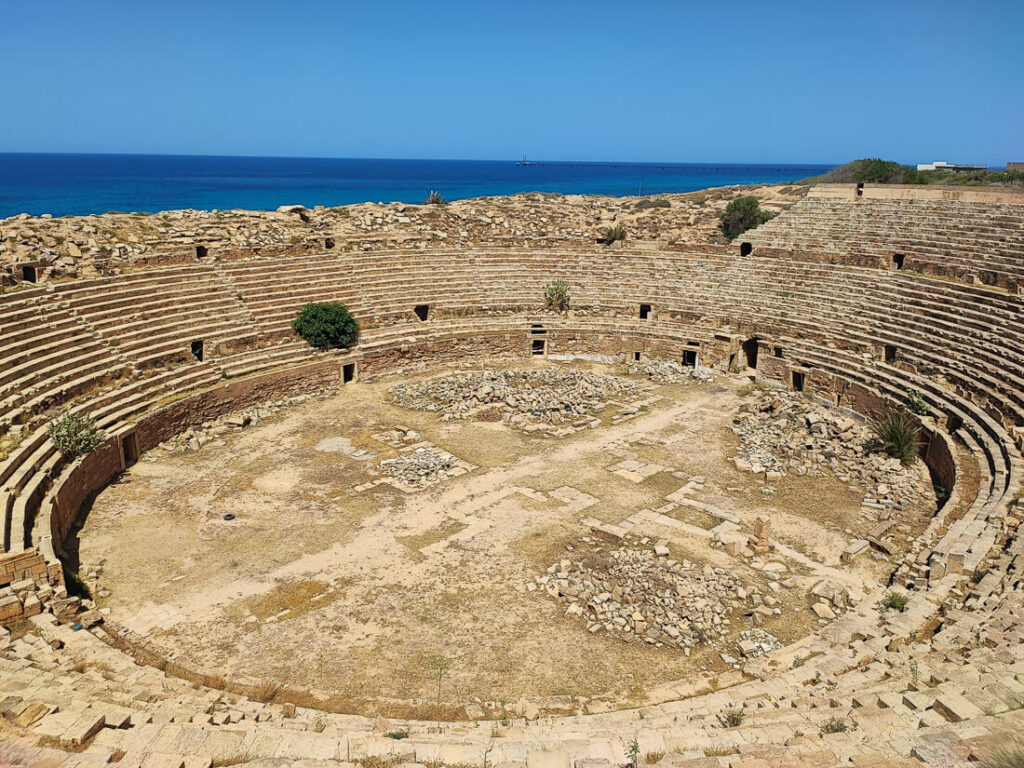
2 – Admiring the Italian Heritage in Tripoli
As in Eritrea , Italians left their footprint in Libya, leaving behind a very strong coffee culture and the most beautiful buildings in the country.
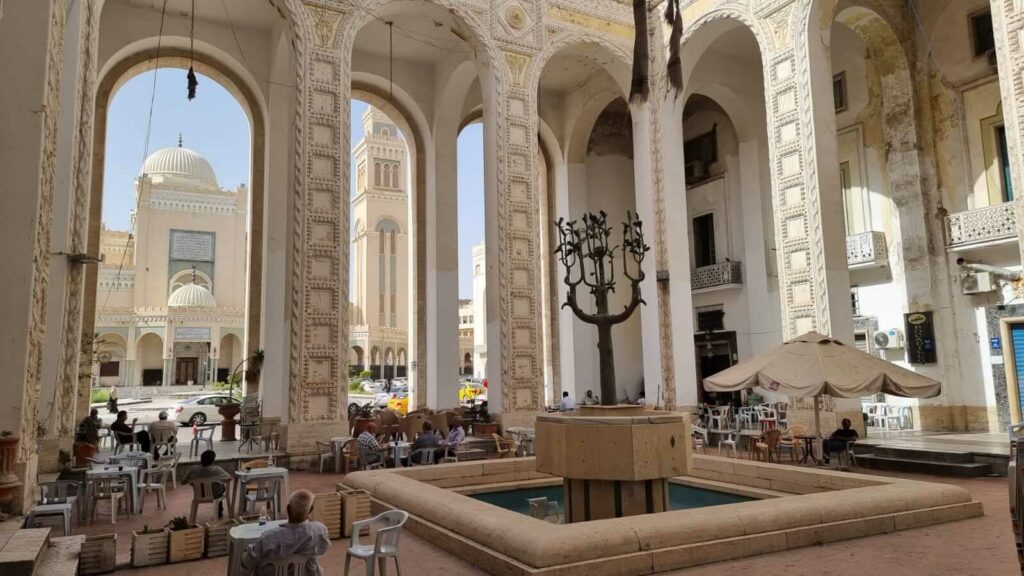
3 – Experiencing the Libyan desert
Whether you are driving from town to town, or just having tea with the Tuaregs, few countries in the world have such a vast, empty desert.
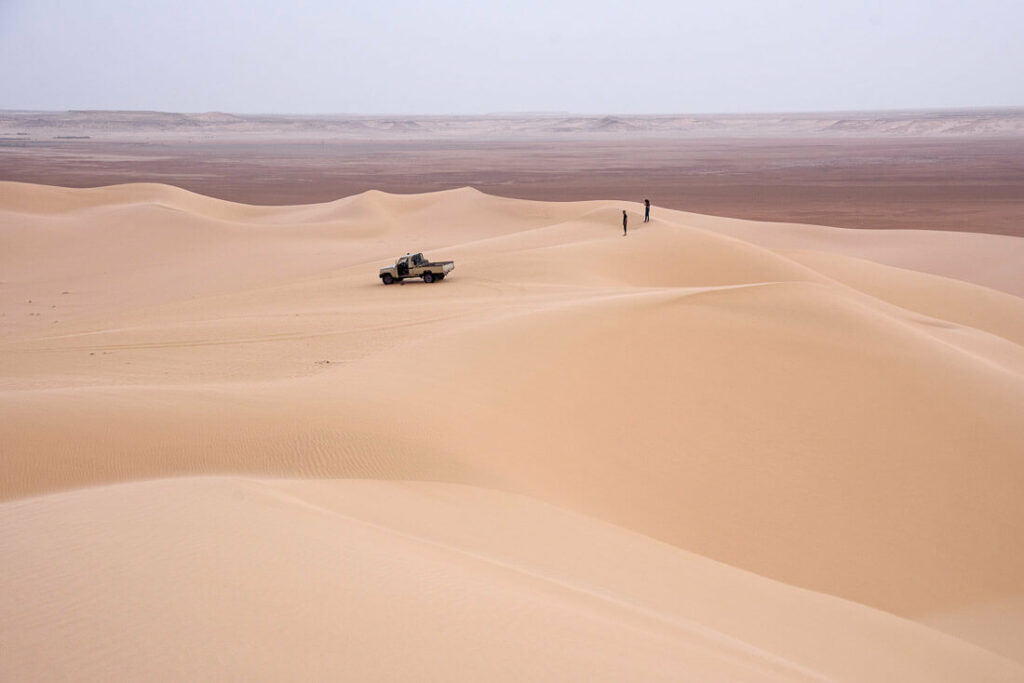
4 – Visiting the ancient caravan city of Ghadames
Ghadames is an ancient desert town and oasis, home to an entangled and massive old city composed of hundreds of pathways, which also turns out to be a UNESCO Heritage site .
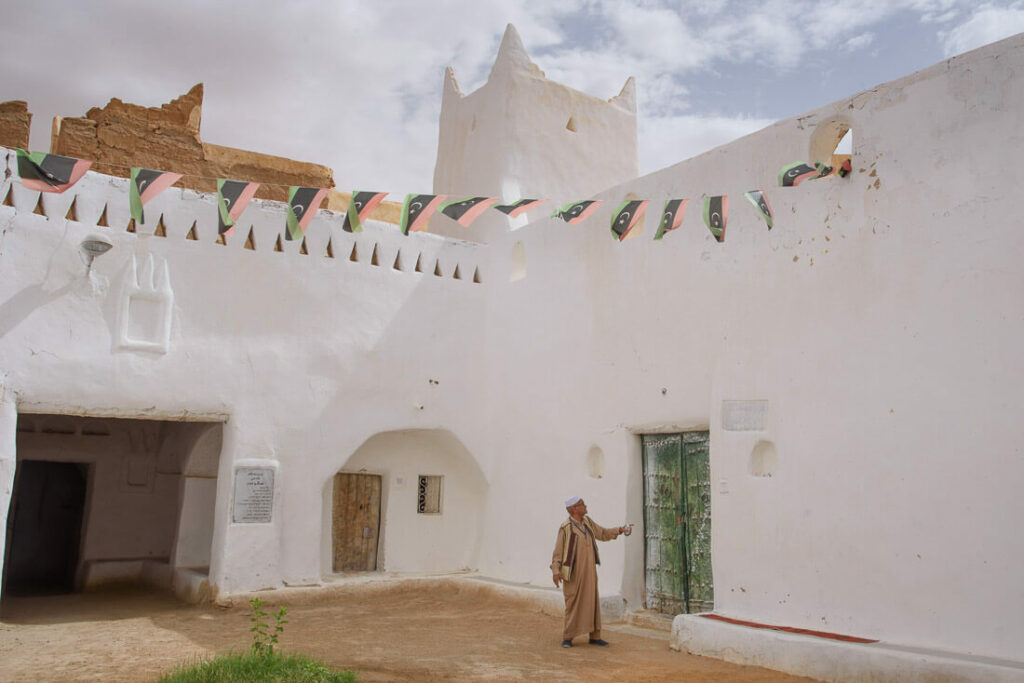
5 – Learning about the current crisis in Misrata
Misrata was one of the most affected cities during the Libyan Civil war, the legacy of which is still very visible. Today, the city features a brand-new museum about the crisis.

💻 Internet and connectivity in Libya
As expected, Wi-Fi isn’t particularly reliable in Libya, but you can easily get a local SIM card at the airport.
I personally bought a SIM card packed with 20GB of data for just 39LYD (around 8 USD), which was more than enough for just 6 days.
Get a VPN for traveling in Libya
You should always use a VPN when you travel, especially when you connect to public Wi-Fi networks.
Your connection will be much safer.
Moreover, you will be able to access content which is typically censored in Libya.
I recommend ExpressVPN – Extremely easy to use, fast and cheap.
If you want to learn more about VPN, check: Why you need a VPN for traveling .
💰 Budget and money: how much does it cost to travel to Libya?
In Libya, they use the Libyan Dinar (LYD) and approximately:
1 USD = 5 LYD
Obviously, the currency in Libya is not very stable, so do check the exact exchange rate before departure.
Can you use credit or debit cards in Libya?
No, you can’t, so do bring all your money in cash.
However, you won’t need much money because you are likely to travel to Libya on a tour, where pretty much everything is included.
In 6 days, I spent the equivalent of 30€, just for a few night meals which weren’t included in Tripoli.
Where can I exchange money?
I believe your local guide will help you with that but the main area for exchange is in a specific place in the old city of Tripoli.
How much does it cost to travel to Libya?
As mentioned, the only way to travel to Libya is by purchasing a tour, which tends to include all expenses but in any case, here’s a summary of the most typical costs:
- Visa: 60€ (in Madrid embassy, at least)
- Round trip flight Tunis Tripoli with Libyan Wings: 250€
- Meal in a local restaurant: around 25-40 LYD
- Meal in a fancy restaurant: from 50-90LYD
- Espresso or cappuccino in a local coffee shop: 2 LYD
- Espresso or cappuccino in a fancy café: 5 LYD
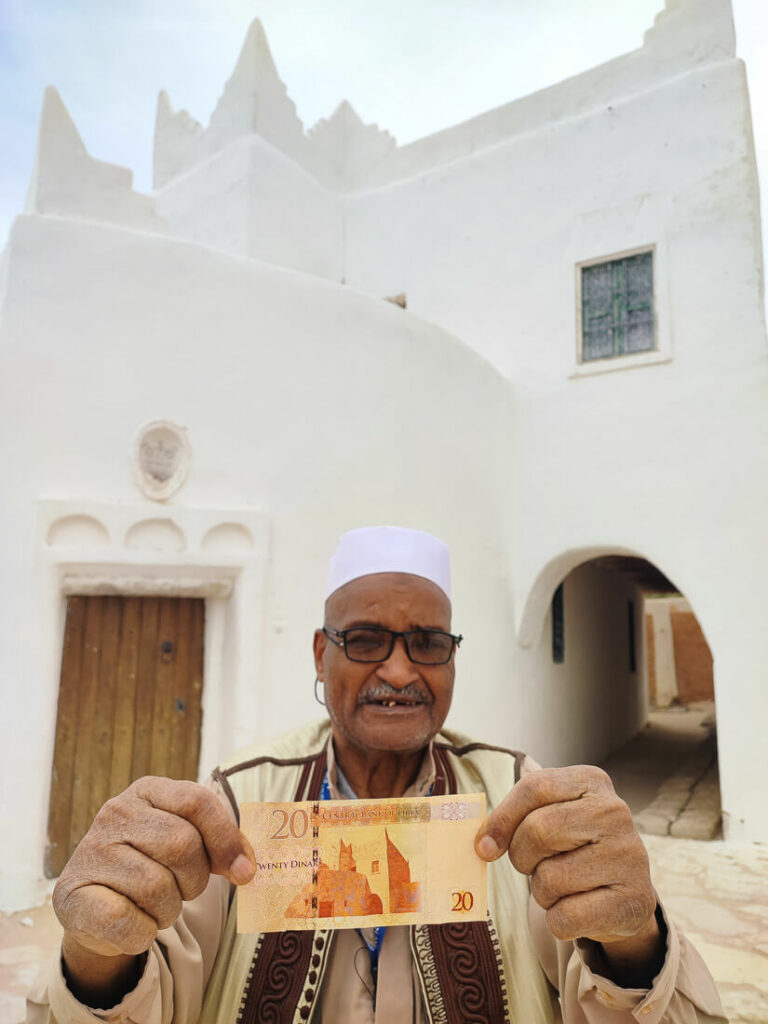
🛺 How to get around Libya
It doesn’t really make sense to add a getting around section since you’ll be traveling from city to city by car, with your local guide but still, here are a few things to keep in mind:
- Gas is extremely cheap, the second cheapest in the world after Venezuela.
- Despite having some of the most massive oil reserves, there’s an oil shortage, and many gas stations are virtually empty. On our way to Ghadames, we had to travel with three large cans filled with gas, since finding gas can be a gamble.
- The driving is bad, Libyans don’t really like to follow traffic rules, but that didn’t surprise me.
- The coastal road is sort of busy, but the roads leading inland are absolutely empty, only desert, and barely any cars.

🕌 Libya: the country, people and culture
Along with Morocco, Mauritania , Tunisia and Algeria, Libya is one of the 5 countries that compose the Maghreb region.
It is the 4th largest country in Africa, and the 16th in the world, but its land is only inhabited by 6 million people, making it one of the least densely populated countries in the world .
People, the Libyans
Unlike other African countries, Libya has a pretty homogenous society.
Arabs: Most Libyans can be classified as Arabs. However, while the western part of Libya has more similarities to Morocco, Algeria and Tunisia , the eastern part has more resemblance to Egypt. In fact, this cultural difference is what has left the country divided, and dictates the international agenda too, since both Governments are supported by their respective foreign counterpart.
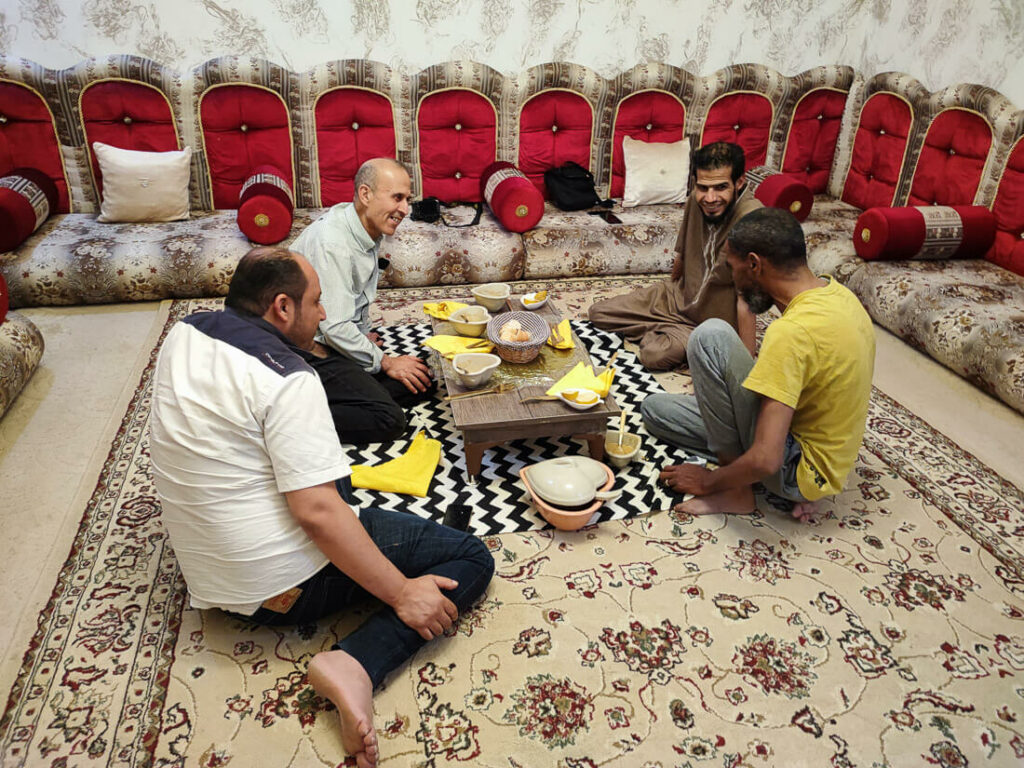
Berbers: Apparently, 5% of the total Libyan population are Berbers, the indigenous ethnic group in north Africa before the Arabs came. They have their own language and folklore, and usually, they have a darker skin. I found Berbers from Libya had a stronger identity than Berbers in Tunisia or Morocco, since Berber flags were seen everywhere. However, they have absolutely no problem in saying they are Libyans. On the way to Ghadames, you’ll see lots of Berber towns.

In Libya, they speak Arabic and, like its people, while the dialect spoken in West Libya is similar to Tunisia’s, in East Libya it is similar to Egypt’s.
Do people speak English in Libya?
Not much but again, you are likely to be with a local guide the whole time, so communication shouldn’t be much of an issue.
Libyans are Sunni Muslims, but in Tripoli, you can find some churches that are frequented by the small Christian community.
Like Bashar al Assad in Syria , Muammar Gaddafi was a secular dictator who always condemned fundamentalist and religious extremists but unlike in Syria , where there’s a very significant secular society, I found the people in Libya to be extremely religious and traditional.
The few women you see in the street always wear hijab and to my surprise, many of them wore the niqab, something rarely seen in North Africa.
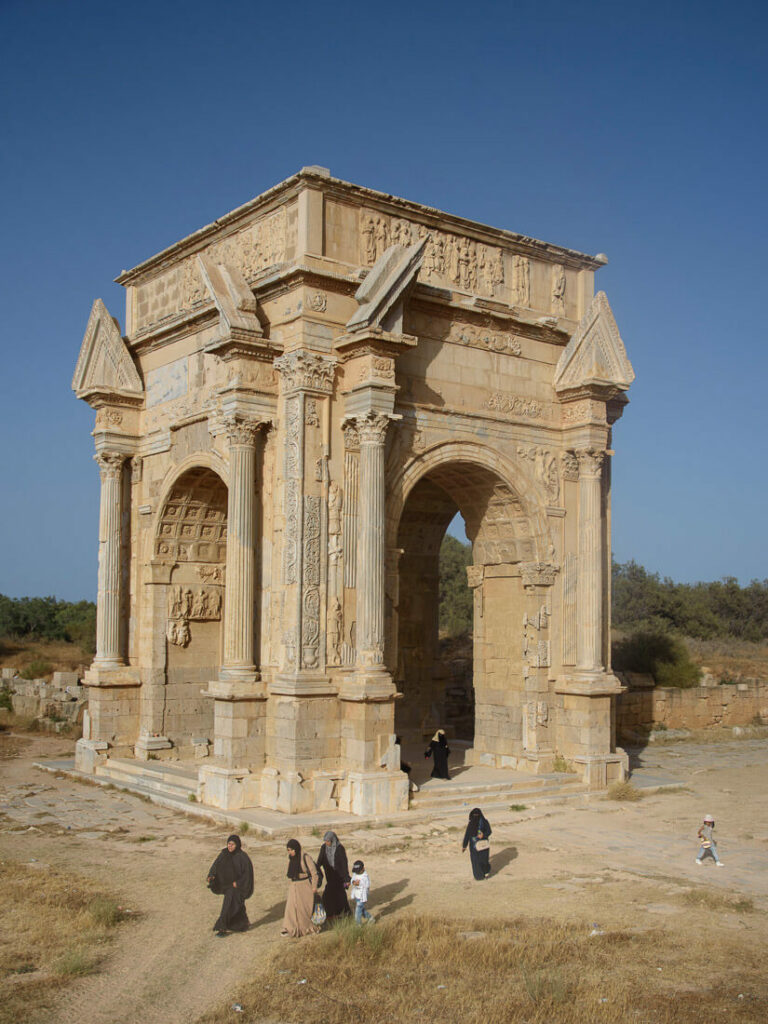
🍲 Libyan cuisine
Food won’t be the highlight of your trip, but some of their dishes aren’t bad.
I can’t tell what’s food like in East Libya, but in West Libya, food is similar to other countries in the Maghreb.
Cous-cous is their signature meal and what I like about it is that it’s quite juicy, usually tomato-based, like in Tunisia, while in Morocco I always found it to be drier. Grilled meat with white rice is always available in most restaurants and, thanks to the Italian influence, pasta too.
In Tripoli, you can actually find many Italian restaurants, a very popular chain being Caffe di Roma, where you have a wide variety of pastas and pizzas to choose from. It’s not the best pasta ever but after a few days of just eating cous-cous, it wasn’t bad at all.
Another dish I tried was usban , a Libyan sausage filled with rice and meat, too heavy for my taste, but sort of tasty.
Alcohol in Libya
Since Gaddafi came into power in 1969, Libya has been a dry country.
Being such a secular ruler, I wondered why he banned alcohol. Some Libyans believe he banned it so people would not get drunk and start talking about politics, saying bad things about the Government. That’s hard to believe, since not even Kim Jong Un does that.
Coffee in Libya
I am a big coffee drinker, especially in the morning, so whenever I visit a predominantly tea country, I always struggle, and I thought Libya would be one of those, but I was wrong.
Coffee culture in Libya is a big deal and, due to the Italian influence, they prepare it in a pretty sophisticated way, with so much love, and always with the right amount of foam.
What was even more surprising, however, is that you can also have really good coffee in more rural towns, like Ghadames for example, and even in the random villages you find along the road.
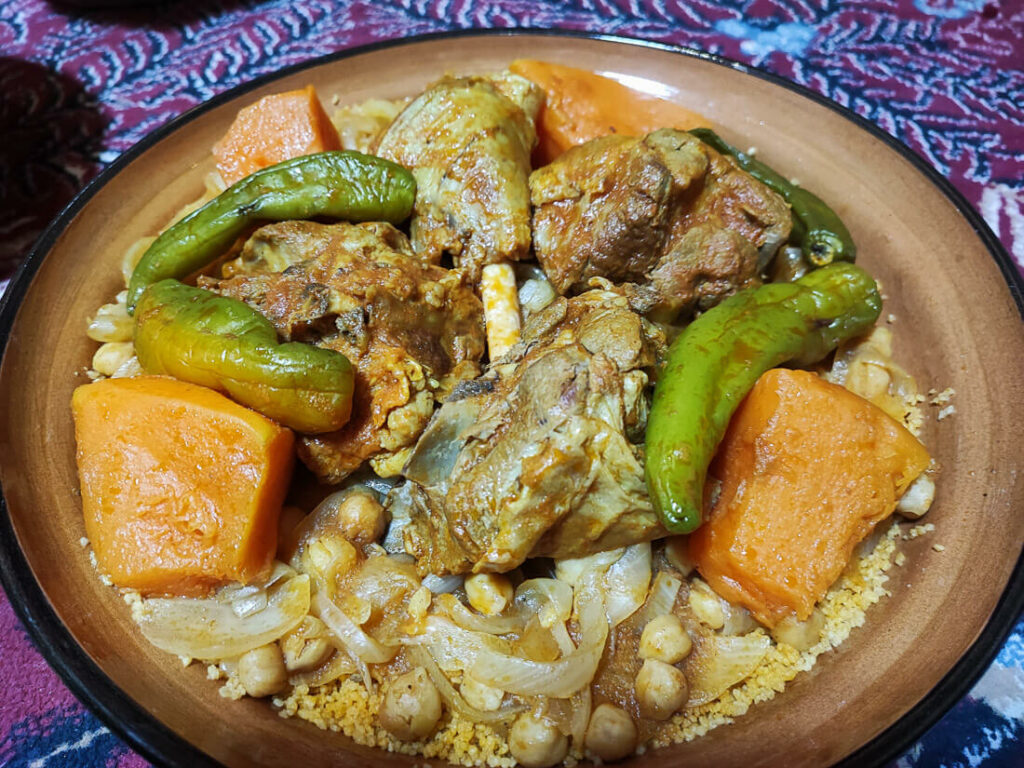
🏨 Where to stay in Libya
There aren’t many hotels in Libya, but there are enough to accommodate the few tourists, business people, and diplomats that visit the country.
Where to stay in Tripoli
Mid-range – Hotel Victoria – This is the preferred hotel for travelers, featuring a rooftop with excellent views to the city.
5 stars – Sheraton Hotel – Better than Victoria, of course.
Top-end – Corinthia Hotel Tripoli – The best hotel in town
Where to stay outside of Tripoli
In Gadhames: we stayed at Ghadamis Hotel , a massive hotel with traditional architecture which opened 1 or 2 years before the beginning of the war but, since it’s government-owned, it has remained open. We stayed there for two nights, and we were literally alone.
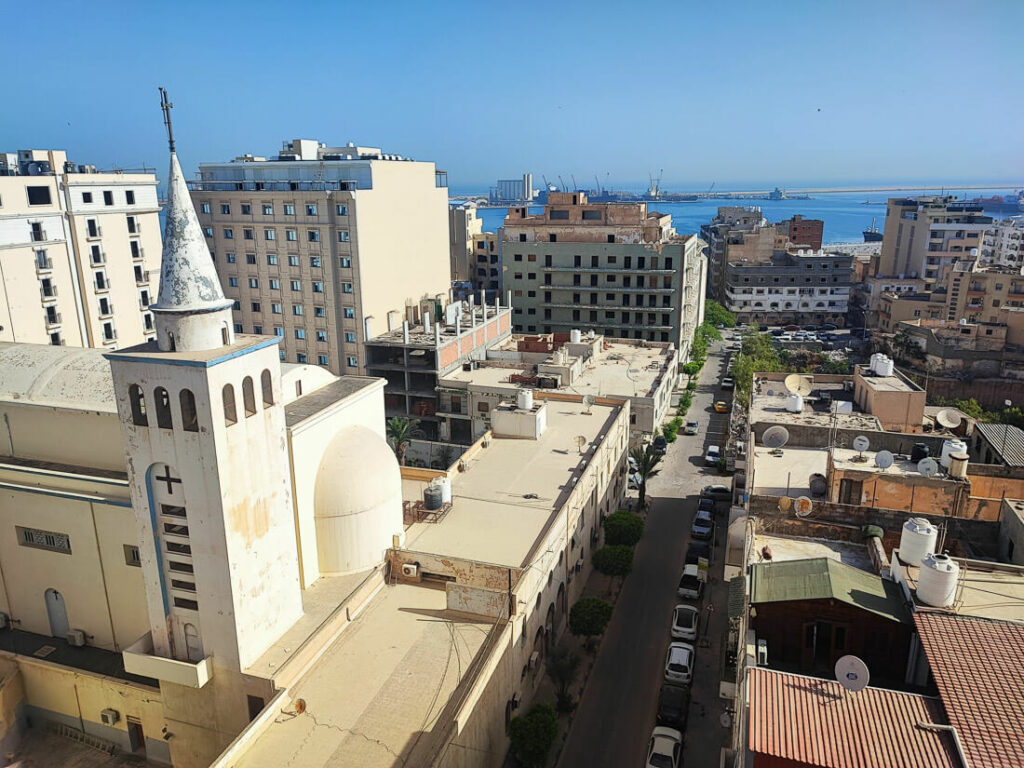
💃Solo female travel in Libya
Independent travel is not allowed in Libya, so solo women will always go with the local guide and the tourist police, making things much easier for them.
My local guide said he has had many female clients – some of them came alone, while others with a partner or friend – and he said all of them had a great time.
Have you been to Libya (as a solo female) and want to write a guest post for Against the Compass to tell us about the experience?
Then, kindly shoot me an email at [email protected]
❗ More Information for traveling to Libya
📢 In my Travel Resources Page you can find the list of all the sites and services I use to book hotels, tours, travel insurance and more.
Travel guides to other countries in Africa
- Ethiopia Travel Guide
- Eritrea Travel Guide
- Somaliland Travel Guide
- Travel Guide to Sudan
- Travel Guide to Egypt
- Mali Travel Guide
- Travel Guide to Mauritania
- Tunisia Travel Guide
You will also like our Syria travel guide , Iraq travel guide and Haiti travel guide .
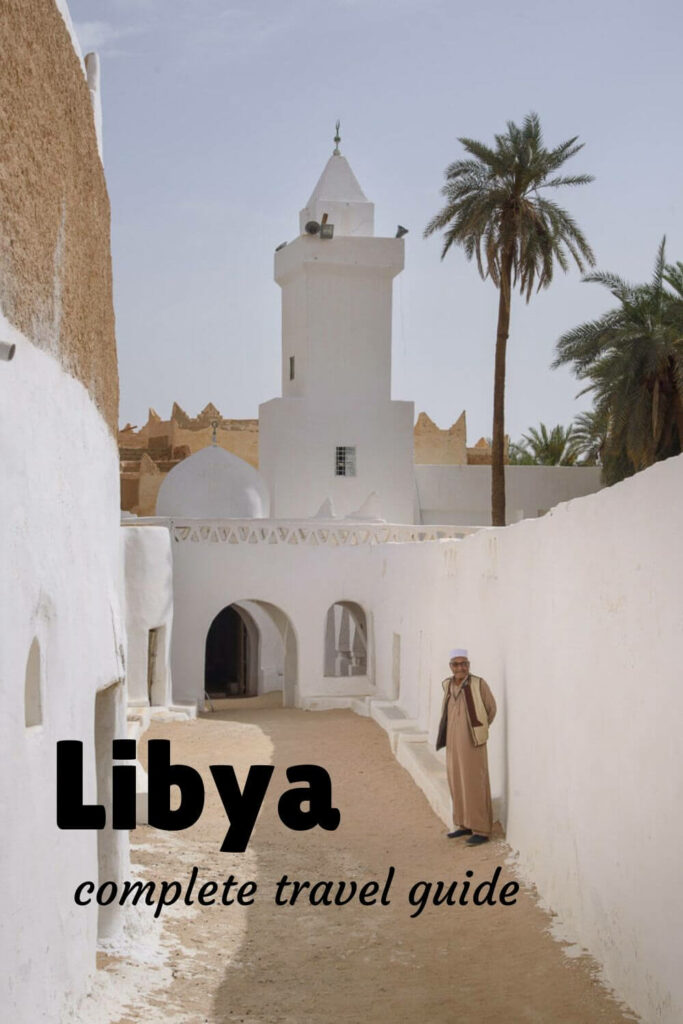
25 comments
Another great article! The photos you shared remind me a lot of Tunisia. Northern Africa is such a brilliant place to travel. Thanks for sharing.
I admire your courage for traveling to Libya. Not many think about visiting this country that has been plagued by civil unrest. Even the crime rate in this country is quite high.
What are the entry requirements for a UK Citizen? Is it possible for visa upon arrival?
Not possible visa on arrival. Please check visa section,the requirements apply to UK citizens too
Hi Joan, I’m an American and would like to arrange an independent trip to Libya for March, 2023. I can’t seem to figure out how to reach you through your contact site here.
Ok….so I’m planning a trip to Algeria, Tunisia, Libya and Egypt in March. Is it possible to drive into Libya from Tunisia? Because there are certainly ZERO flights flying INTO Libya from almost anywhere. Unless you know of a way to fly in. I only wish to visit Leptis Magna.
Also, how would I go about obtaining a Visa as a US citizen? Is it still only a business visa? Any other way of entering? A few $100 bills in my pocket? Talk to me.
Hello Anthony, there are several flights a day from Tunis into Tripoli. The airport is called Mitiga. Tunis Air, Libyan Wings and Gadhames Air are the main airlines. You can enter by road, but your fixer would have to wait on the other side, and it’s a long way to Leptis.
As of today, only business visa, and for US citizens little chance to get it.
I would love to make a return trip to Libya especially Tripoli. I worked there in the 60s. I never made it to Ghadames which fascinates me. You have given so much information and I love the idea that there is still a bit of Italy there even if just in the food!
Thanks Patricia. You were in Tripoli during the golden times 🙂
I am very interested in traveling to Libya. I saw many pictures of Lake Gaberoun in Ubari on the internet and thought they were fantastic. Will that oasis be accessible in 2023?
Hi David, a tourist was arrested for nearly 2 months last year for visiting that lake, so I am not quite sure when will it be open
Hello, I am interested in joining one of your tours to Libya but would like to know if an extension to the south of the country would be possible? I’m thinking of the areas around Waw an Namus and Harat Zuwayyah.
Pending security clearance, tourist visa on arrival is now possible.
Can you visit east Libya like Benghazi these days?
They opened it recently but haven’t been there yet
Wait, what??? You can get a Tourist Visa in Libya now? You can get it on arrival and not months in advance??
Why does the FCO (foreign and commonwealth office) recommend not travelling to Libya? They say it is potentially dangerous. I am being offered work at an oil company there soon and am a bit worried about the comments made by the fco not to travel there.
Is the visa only valid for the duration of the tour?
You can extend it.
Which country are you from?
how utterly raciest this journalist is calling the leader and absolute dictator despite the deep respect the people of libya afforded him. just try comming to libya and spouting your opinions out . obviously the person is a westeen tv news addict drinking all the supposed naratives not knowing history or politics of this western destroyed land in their greed for resources and exploitation.
Come to Libya and you’ll see the little respect Libyans have for him!
I’m still committed and determined to travel to Libya in 2024. How are the tensions in the Middle East affecting attitudes to foreigners there?
I have heard that Libya has an new e-visa program now (evisa.gov.ly). Does it still need a tour/LOI, and is it usable only by air or also by land?
Hi Ethan, yes, there’s a new evisa system now, but it’s too new… I still need to get experience with it.
Leave a Comment Cancel reply
Your email address will not be published. Required fields are marked *
Notify me when new comments are added.
Top Libya Attractions
Things to do in libya, explore popular experiences, popular cities in libya.
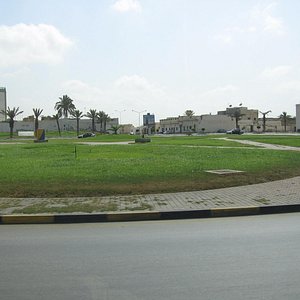
Top Attractions in Libya
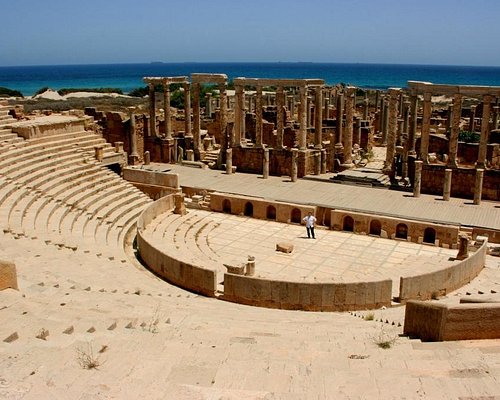
What travelers are saying

An official website of the United States government
The .gov means it’s official. Federal government websites often end in .gov or .mil. Before sharing sensitive information, make sure you’re on a federal government site.
The site is secure. The https:// ensures that you are connecting to the official website and that any information you provide is encrypted and transmitted securely.
- Publications
- Account settings
Preview improvements coming to the PMC website in October 2024. Learn More or Try it out now .
- Advanced Search
- Journal List
- Libyan J Med
- v.2(3); 2007
Medical Tourism and the Libyan National Health Services
Adel el taguri.
Department of family and community medicine, Al Fateh University, Tripoli, Libya
Medical tourism is a term that is used frequently by the media and travel agencies as a catchall phrase to describe a process where people travel to other countries to obtain medical, dental, and/or surgical care [ 1 , 2 ]. Leisure aspects of traveling are usually included on such a medical travel trip [ 1 ]. The term is also used to describe a situation where doctors travel to other places to deliver services to endogenous populations [ 3 ].
Many factors have led to the recent increase in popularity of medical tourism. Among these factors are the absence of a particular service and the high cost of health care in some countries of origin on one side, and the ease and affordability of international travel, and the improvement of technology and standards of care in host countries on the other side. This phenomenon cannot be separated from globalization and tendency for a more liberal world trade. In countries that operate from a public health-care system, it can take a considerable amount of time to get needed medical care. In Britain and Canada, for example, the waiting period for a hip replacement can be a year or more, while in Bangkok or Bangalore, a patient can be in the operating room the morning after getting off a plane [ 2 ]. The post-surgery mortality rate in the 15,000 heart operations done every year in Scots Heart Institute and Research Centre in Delhi and Faridabad is only 0.8%, which is less than half of most major hospitals in the United States or Europe [ 2 ]. However, the real attraction is price [ 2 ]. The cost of surgery in India, Thailand or South Africa can be one-tenth of the price of comparable treatment in the United States or Western Europe [ 2 ]. A heart operation as an example costs €32000 in the United States, €16000 in Europe, but less than €3000 in India. A full facelift that would cost $20,000 in the U.S. runs at about $1,250 in South Africa [ 2 ]. In addition, clinics in these countries provide single-patient rooms that resemble guestrooms in four-star hotels [ 2 ].
Interventions aimed at medical tourism include cancer treatment, neurosurgery, organ transplantation, aesthetic treatment, dental treatments, eye surgery, kidney dialysis, « preventive health screening» and hip resurfacing [ 2 ]. Other opportunities are constantly being exploited. Examples include different services as aphaeresis tourism in India [ 4 ] and climatotherapy in Egypt [ 5 ].
Medical tourism is a rapidly growing industry in many countries. India is becoming a «global health destination». Encouraged by the government, India is promoting the «high-tech healing» of its private healthcare sector as a tourist attraction [ 1 , 2 ]. More than 100 000 foreigners visited India for medical treatment in the year 2005. India estimates that medical tourism could bring as much as $2.2 billion per year by 2012. Besides India, popular international medical travel destinations include Singapore and Thailand. About 374, 000 visitors came to Singapore purely to seek healthcare in 2005, half of them from the Middle East [ 2 ]. South Africa promotes an attractive «medical safari» catchphrase: Come to see African wildlife and get a facelift in the same trip. Other countries include Tunisia which is attracting Italians, British and French besides the so- called traditional visitors from Libya and Algeria [ 6 ]. The list of countries currently promoting medical tourism include many others such as Argentina, Bolivia, Brazil, Cuba, Costa Rica, Jamaica, Jordan, Hungary, Latvia, Lithuania, Malaysia and the Philippines [ 2 , 3 ]. Some hospitals in certain countries are gaining the confidence of their customers by obtaining hospital accreditation from international bodies in the United States [ 2 ]. Dubai, already known for its festival and other luxury attractions, is planning to open the Dubai Healthcare City by 2010. This is expected to be the largest international medical centre between Europe and Southeast Asia and it is hoped to become an internationally recognized location of choice for quality healthcare and an integrated centre of excellence for clinical and wellness services, medical education and research [ 2 ]. An international medical travel conference (IMTC) was held in December 2006 and some web sites such as ArabMedicare.com were established to accompany the needs of this growing market.
In spite of the aforementioned rewards, medical tourism is not without risks [ 3 ]. Medical tourism can do harm to national health services of the host as well as the country of origin. Besides cultural and language issues, there are risks inherent in traveling as accidents, exposure to different infectious diseases, risks from traveling soon after surgery, impossibility of treating chronic disease after a single consultation, the non familiarity of how a certain specialty applies to other communities, the on-off consultations, the limited possibility for follow up, the absence of record of the consultation [ 3 ], and most importantly fraud and abuse.
The total amount of money spent by Libyans on both forms of medical tourism is difficult to estimate. It ranges between $100-200 millions per year for treatment abroad, but the accurate figures are not available. The form of medical tourism where doctors rather than patients travel, gained a momentum with the increased role of private practice in health service delivery. There is a real threat from the growing market of medical tourism in the region on the public health oriented national health system in Libya. The two neighboring countries that are mostly visited by Libyans have a lower performance of National Health Service in comparison to Libyan National Health services with an objective assessment as revealed by infant mortality rate, life expectancy at birth, maternal mortality ratio and proportion of low birth weight [ 7 ]. Giving the non-popularity of tourism among the Libyan population, traveling in itself is an important event in one's life. We should not deny that in many cases quality of care, communication skills of health-care givers and patient satisfaction are better in visited countries. Demands are rarely seen to be an important element in the predominantly centralized planning of health services in Libya. Initial visits to these «tourist» private clinics are seen as means to attract other clients. This goes usually through undermining National Health Services in Libya. In many instances there is no justification for that. In addition to our tendency to idealize others, many of the criteria used by patients are very subjective and represent demands rather than needs. Some of these subjective criteria that we met were related to quality of food or clothes offered in hospitals or certain procedures that are seen as novel experience.
It is unlikely that this phenomenon of medical tourism will decrease in magnitude. It is also unreasonable to think that a country with a small population will be able to deliver all service demands and needs of the population. For example, the cost-benefit analysis of some interventions as hepatic transplantation would not permit the minimum number of transplantations needed to insure quality unless these interventions are organized at the regional level. Solutions are multifaceted. These would include; improving hospital based services and ambulatory care; increasing responsiveness of national health services to patients’ needs as basic amenities that are highly valued by the consumers such as clean waiting rooms or adequate beds and food in hospitals; partnership with the private sector; delivering quality care with continuous evaluation by different indicators related to structure, process and outcome of healthcare services, and using clinical governance, performance management and SMART objectives and targets to evaluate performance of health establishments. Health insurance schemes can also play an important role in controlling this phenomenon as well as supervising treatment processes and ensuring stewardship.
Travel, Tourism & Hospitality
Contribution value of tourism to GDP in Libya 2019-2020
Contribution value of the travel and tourism industry to the gross domestic product (gdp) in libya from 2019 to 2020 (in million u.s. dollars).
Additional Information
Show sources information Show publisher information Use Ask Statista Research Service
2019 to 2020
Other statistics on the topic
Inbound tourist visits to the UK 2002-2023
Leisure Travel
Leading UK cities for international tourism 2019-2022, by visits
Travel and tourism's total contribution to GDP in the UK 2019-2022
Outbound tourism visits from the UK 2019-2022, by purpose

- Immediate access to statistics, forecasts & reports
- Usage and publication rights
- Download in various formats
You only have access to basic statistics.
- Instant access to 1m statistics
- Download in XLS, PDF & PNG format
- Detailed references
Business Solutions including all features.
Other statistics that may interest you
- Number of international visitors to Australia FY 2023, by purpose of visit
- Number of short-term visitor arrivals to Australia 2012-2014, by travel reason
- Market size of the tourism sector worldwide 2011-2024
- Number of international tourist arrivals in Morocco 2014-2020, by mode of transport
- Number of international tourist arrivals in Morocco 2014-2020, by region
- International tourists in Morocco 2014-2019, by form of trip organization
- International tourist arrivals in China 2010-2021
- Fastest emerging tourism destinations worldwide for 2014 to 2024
- Change in number of visitors from Mexico to the U.S. 2018-2024
- Annual revenue of China Tourism Group Duty Free 2013-2023
- Countries with the highest number of inbound tourist arrivals worldwide 2019-2022
- Countries with the highest outbound tourism expenditure worldwide 2019-2022
- Leading countries in the MEA in the Travel & Tourism Competitiveness Index 2018
- Foreign exchange earnings from tourism in India 2000-2022
- Number of international tourist arrivals in India 2010-2021
- International tourist arrivals in Europe 2006-2023
- International tourism receipts of India 2011-2022
- Italy: sources of inspiration for holiday planning 2017
- Number of overnight stays in hotels in the Faroe Islands 2019, by country of origin
- Number of international tourist arrivals worldwide 2005-2023, by region
- Forecasted tourism expenditure UK 2014-2025
- Opinions about sustainable tourism in Norway 2018
- Economic contribution of tourism in England (UK) 2013
- Leading non-EU destinations of tourists resident in the EU 2018
- Monthly number of overnight visitors in the city of Madrid 2019-2022
- Operating income HanaTour 2014-2022
- Total revenue of tourist hotels in Taiwan 2012-2022, by origin of funds
- Number of inbound tourist arriving by road transport Egypt 2008-2019
- Number of tourists who traveled on a package tour Egypt 2009-2018
- Number of inbound tourist arrivals Egypt 2018, by form of trip organization
- Length of stay of international tourists in commercial accommodations Egypt 2007-2019
- Share of tourist expenditure in Morocco 2019-2021, by purpose
- Share of domestic and international tourist expenditure in Morocco 2019-2021
- Leading travel companies that comes to mind in Egypt by brand 2018
- Share of online travel searches in Egypt by device 2018
- Share of travel destination evaluation In Egypt by transportation factors 2018
- Share of payments for flights in Egypt by method 2018
Other statistics that may interest you Statistics on
About the industry
- Premium Statistic Number of international visitors to Australia FY 2023, by purpose of visit
- Basic Statistic Number of short-term visitor arrivals to Australia 2012-2014, by travel reason
- Premium Statistic Market size of the tourism sector worldwide 2011-2024
- Premium Statistic Number of international tourist arrivals in Morocco 2014-2020, by mode of transport
- Premium Statistic Number of international tourist arrivals in Morocco 2014-2020, by region
- Basic Statistic International tourists in Morocco 2014-2019, by form of trip organization
- Premium Statistic International tourist arrivals in China 2010-2021
- Basic Statistic Fastest emerging tourism destinations worldwide for 2014 to 2024
Selected statistics
- Premium Statistic Change in number of visitors from Mexico to the U.S. 2018-2024
- Premium Statistic Annual revenue of China Tourism Group Duty Free 2013-2023
- Premium Statistic Countries with the highest number of inbound tourist arrivals worldwide 2019-2022
- Premium Statistic Countries with the highest outbound tourism expenditure worldwide 2019-2022
- Premium Statistic Leading countries in the MEA in the Travel & Tourism Competitiveness Index 2018
- Basic Statistic Foreign exchange earnings from tourism in India 2000-2022
- Basic Statistic Number of international tourist arrivals in India 2010-2021
- Premium Statistic International tourist arrivals in Europe 2006-2023
- Basic Statistic International tourism receipts of India 2011-2022
Other regions
- Premium Statistic Italy: sources of inspiration for holiday planning 2017
- Premium Statistic Number of overnight stays in hotels in the Faroe Islands 2019, by country of origin
- Basic Statistic Number of international tourist arrivals worldwide 2005-2023, by region
- Basic Statistic Forecasted tourism expenditure UK 2014-2025
- Premium Statistic Opinions about sustainable tourism in Norway 2018
- Basic Statistic Economic contribution of tourism in England (UK) 2013
- Premium Statistic Leading non-EU destinations of tourists resident in the EU 2018
- Premium Statistic Monthly number of overnight visitors in the city of Madrid 2019-2022
- Premium Statistic Operating income HanaTour 2014-2022
- Premium Statistic Total revenue of tourist hotels in Taiwan 2012-2022, by origin of funds
Related statistics
- Premium Statistic Number of inbound tourist arriving by road transport Egypt 2008-2019
- Premium Statistic Number of tourists who traveled on a package tour Egypt 2009-2018
- Premium Statistic Number of inbound tourist arrivals Egypt 2018, by form of trip organization
- Premium Statistic Length of stay of international tourists in commercial accommodations Egypt 2007-2019
- Basic Statistic Share of tourist expenditure in Morocco 2019-2021, by purpose
- Basic Statistic Share of domestic and international tourist expenditure in Morocco 2019-2021
- Premium Statistic Leading travel companies that comes to mind in Egypt by brand 2018
- Premium Statistic Share of online travel searches in Egypt by device 2018
- Premium Statistic Share of travel destination evaluation In Egypt by transportation factors 2018
- Premium Statistic Share of payments for flights in Egypt by method 2018
Further related statistics
- Basic Statistic Contribution of China's travel and tourism industry to GDP 2014-2023
- Premium Statistic Number of visitors to the U.S. from Russia 2011-2022
- Premium Statistic Music tourist spending at concerts and festivals in the United Kingdom (UK) 2012-2016
- Basic Statistic Importance of BRICS countries to UK tourism businesses 2011
- Basic Statistic Growth of inbound spending in the U.S. using foreign visa credit cards
- Basic Statistic Number of Marriott International hotels worldwide 2009-2023
- Premium Statistic Number of international tourist arrivals APAC 2019, by country or region
- Premium Statistic Middle Eastern countries with the largest international tourism receipts 2018
- Premium Statistic Extended stay lodging units: total number in the U.S. 2008-2016
- Premium Statistic Passenger traffic at Dubai Airports from 2010 to 2020*
Further Content: You might find this interesting as well
- Contribution of China's travel and tourism industry to GDP 2014-2023
- Number of visitors to the U.S. from Russia 2011-2022
- Music tourist spending at concerts and festivals in the United Kingdom (UK) 2012-2016
- Importance of BRICS countries to UK tourism businesses 2011
- Growth of inbound spending in the U.S. using foreign visa credit cards
- Number of Marriott International hotels worldwide 2009-2023
- Number of international tourist arrivals APAC 2019, by country or region
- Middle Eastern countries with the largest international tourism receipts 2018
- Extended stay lodging units: total number in the U.S. 2008-2016
- Passenger traffic at Dubai Airports from 2010 to 2020*

How to Visit Libya in 2024
If you plan to visit Libya in the near future, you might find very little information on how to visit Libya as a tourist.
This is the reason for why we wrote this blog.
Hi, we’re Rach & Marty!
We’ve visited every country in the world and want to help you get the most out of your travels!
Whether you need an expertly planned itinerary , some experienced hints and tips , or just craving a delicious food adventure , we’ve got you covered!
We may earn affiliate commissions from websites we link to, at no cost to you. Click here for details.
Post Updated Jan, 2024
This country has some incredible sights to offer, especially the Roman Cities of Sabratha and Leptis Magna, but it remains one of the least visited countries for tourism.
Tourism was limited during the time of Gaddafi, but after the Arab Spring in 2011, it has been paralyzed by the ongoing conflict.
How to visit Libya? Here are a few points to consider first :
Table of Contents
Libya and “Do Not Travel Warning”
First of all, almost every government has a warning in place to not visit Libya.
This means in most cases your travel insurance will be invalid and your embassy won’t be able to assist you on the ground in case of emergency.
The ongoing conflict in Libya and the instability of the government means Libya is really only suitable for experienced travellers.
Why go to Libya?
Libya has 5 UNESCO Heritage sights, Mediterranean coastlines, Berber villages, and unique desert landscapes.
Tripoli is the capital city and feels more like a mixture of Turkey and the Middle East cities .
And Libya also has some great food .
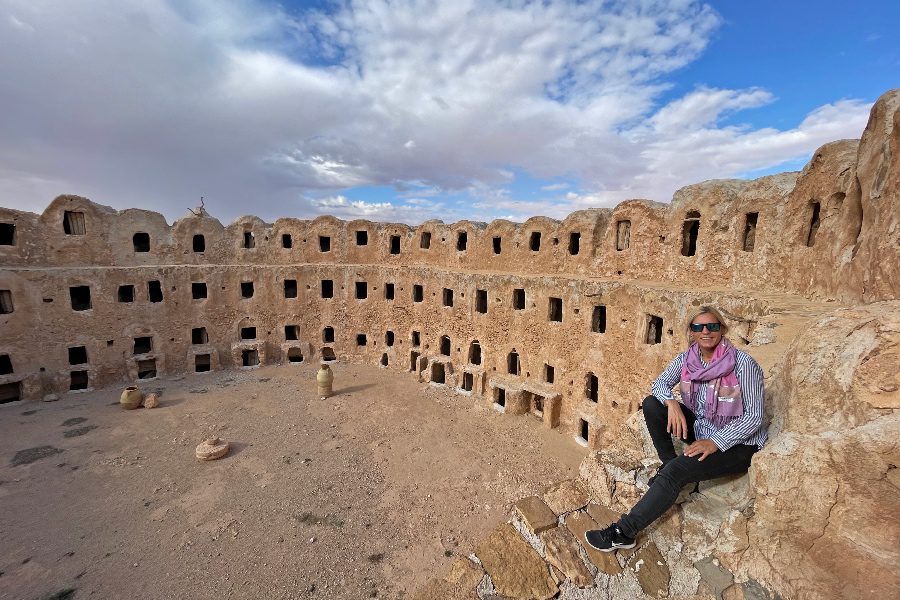
Do you need a visa for Libya?
Passports and visas are required to enter Libya for all nationalities except nationals of Algeria, Jordan, Mauritania, Morocco, Syria, Tunisia, and Turkey.
As Libya does not currently issue a tourist visa , the only option is to apply for a business visa.
If you are maybe working in the construction industry, oil and gas, or are a diplomat, you might be able to visit Libya for work and add a few days to your itinerary to see some sights.
However, if you are planning a trip to Libya as a tourist, you will still need to get your business visa, and for that, you need the help of an agency.
In order to apply for a Libyan visa, you will require an invitation letter from Libya, and this is something the company takes care of on the ground.
It usually takes about 5-7 business days for the invitation letter to be issued and it will also be sent to the embassy where you will apply for your Libyan visa.
There are only a few Libyan Embassies, so best to check where you would apply.
Some suggestions include Rome, London, Washington, Canberra, or Dubai.
Here is the full list of Libyan embassies.
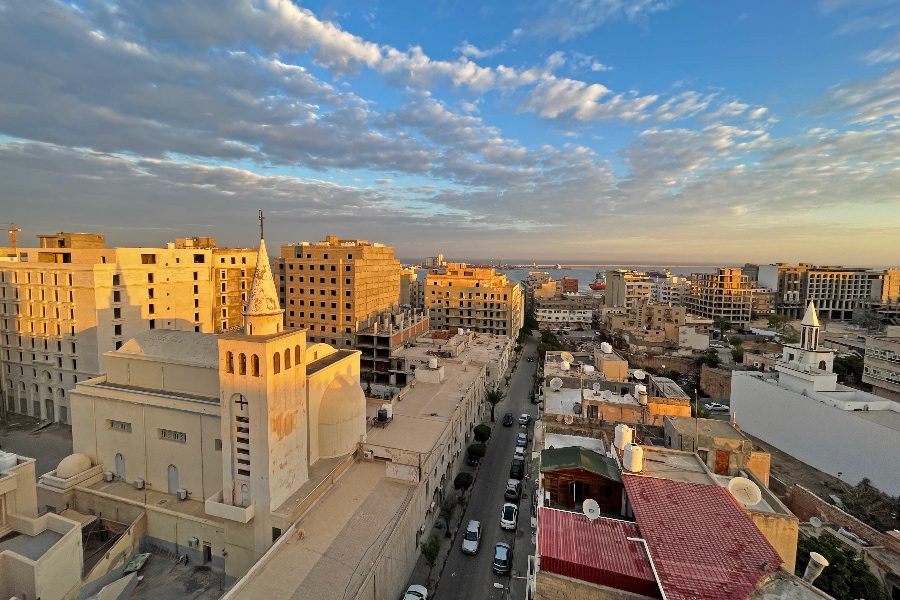
How to visit Libya with a tour company?
Currently, two different contacts/tour agencies organise tours in Libya.
Most travellers visit for 3-5 days as you are limited to what you can visit in Libya.
Your tour will most likely include Tripoli and Tripoli Medina and a visit to the Roman City of Leptis Magna .
You can add a visit to the other Roman city of Sabratha as well as the Berber villages in the Nafusa Mountains plus a visit to the ancient granary Qasr al-hajj.
Finally, you might choose a trip to the desert town of Ghadames.

Two local agencies that may be able to offer you assistance on how to visit Libya.
Sherwes Travel
Offers 3-5 days packages to Libya.
Contact: Ibrahim Usta Email: [email protected] , [email protected]
Overseas Customer Service: +46708454361 (WhatsApp)
Wadi Smalos Tourism Services
Offers 3-5 days packages to Libya but can also arrange a visit to the desert town of Ghadames
Contact: Abubaker Abusahmen Email: [email protected]
+218913633082 (WhatsApp)
How to visit Libya from Tunis
The best way to get to Libya is by flight from Tunis to Tripoli.
Tunis Air as well as Libyan Wings fly this route daily.
As you have to book Libyan wings through an agency, your contact on the ground will organise your flights and e-tickets.
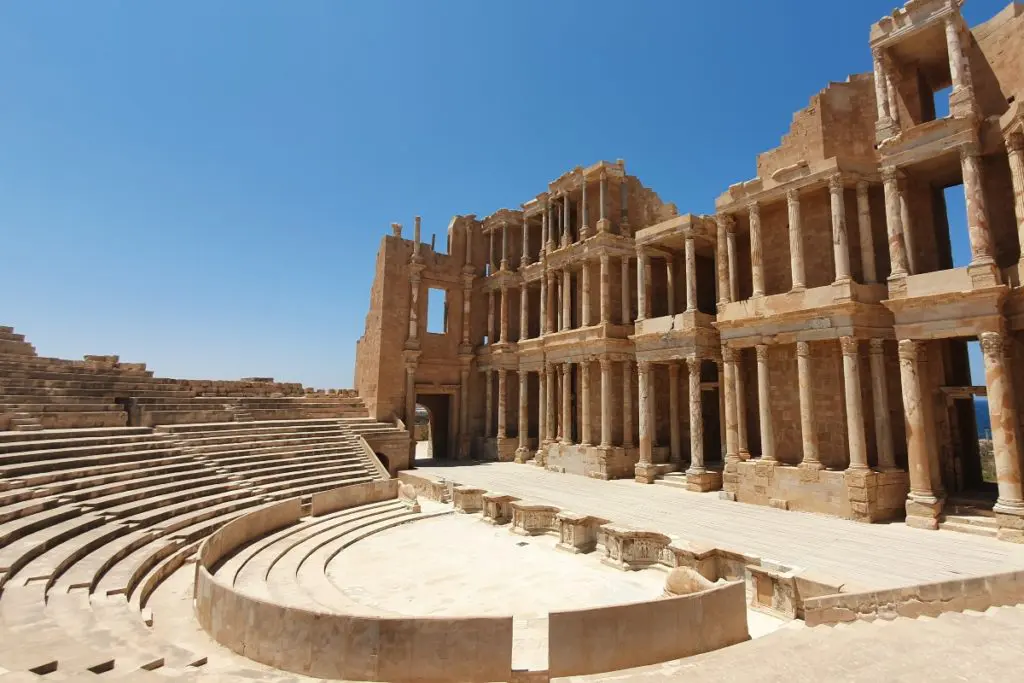
15 Most Popular Foods From Africa
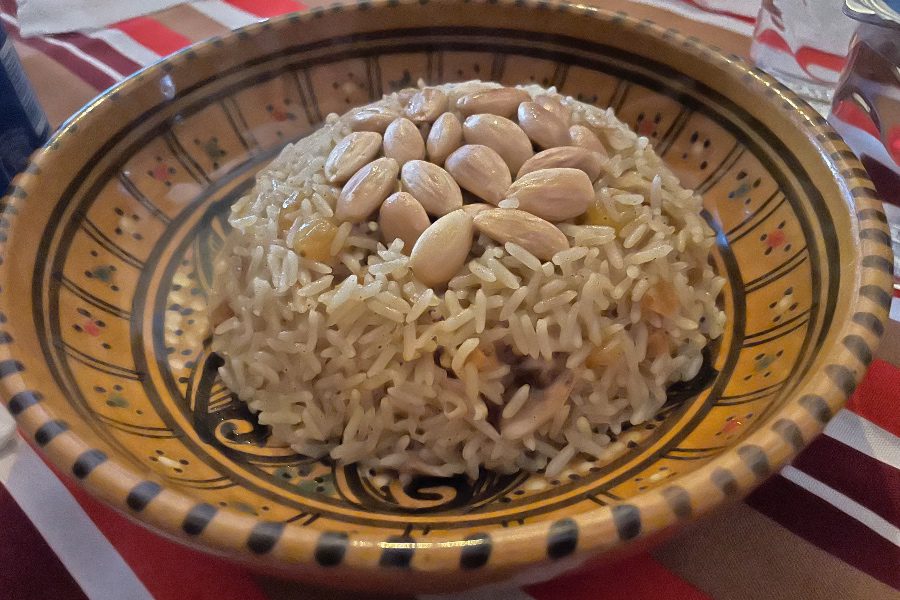
Food of Libya – 10 Most Popular Foods
A Final Word About How to Visit Libya
To read more about our experience here, read more about what it’s like visiting Libya , one of the least visited countries in the world. We visited Libya in November, 2021.
Do you know the answer to how many countries in Africa are there? 54 or 55?
Or perhaps the answer to how many countries are there in the world?
Subscribe to our newsletter!
Expert travel tips, resources and exclusive discounts worldwide
Travel Planning Resources
✈️ Flights : We use Skyscanner to book cheap flights worldwide.
🏨 Accommodation : Booking.com is our preferred platform for booking hotels and accommodation.
🏥 Travel Insurance : We recommend Heymondo ( Get 5% off Heymondo) & SafetyWing
🚌 Transportation : Trainline is the best website to reserve trains. We use Omio to book transport worldwide. For travel in Asia, we use 12Go.
🚘 Car Rental : We use DiscoverCars to book rental cars worldwide.
👫 Group Tours : G Adventures OR compare multi-day tours worldwide with Tourradar .
📸 Day Tours & Trips : GetYourGuide & Viator are the only two platforms you need.
📚 Lonely Planet: The Best Range of Travel Guides & Ebooks , and FREE Shipping! (use code RACHELDAVEY10 for a 10% discount)
🎒 Luggage : Osprey Farpoint 40L Backpack or Samsonite Luggage Range.
🛄 What to Pack: Don’t forget your Universal charger and a good power bank . To help you pack the essentials, here is our ULTIMATE Packing List for all Travellers .
🐶 Become a House Sitter: Join Trusted Housesitters and enjoy FREE accommodation worldwide. Use our invite to receive 25% off your new membership.
💰 Send Money Anywhere: WISE & Revolut are the best online accounts that let you send money, get paid, and spend money internationally. Both are so easy to use and way cheaper than any bank transfer.
📶 Stay Connected: Airalo eSIM allows you to get connected the moment you land at your destination, and you can avoid those expensive data roaming charges. We LOVE this product! Use promo code NOMAD15 for 15% off ALL eSIMs (new Airalo users only) OR use NOMAD10 for 10% off ALL eSIMs (for existing Airalo users)
✅ Check out our Travel Gear and Travel Resources for more valuable tips to save you money!
Tasty Food Adventures

20 Most Popular Foods From Venezuela

Top 5 Popular Foods in South America

20 Delicious Foods From Portugal You Need to Try

Mexico Food Guide – 21 Most Popular Mexican Foods
See all Food Adventure blogs
Expert Travel Guides

The Fascinating Medina in Tunis – 5 Unique Things To Do
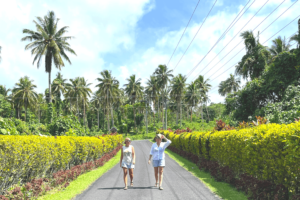
Samoa Is Our Final Country To Visit All The Countries In The World!
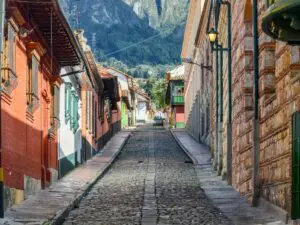
The Perfect 2 Days in Bogota Itinerary
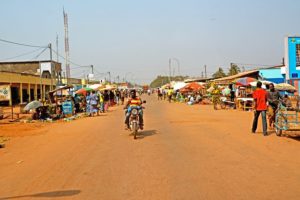
Visiting Central African Republic
See all our Travel Guides
Trusted Hints & Tips
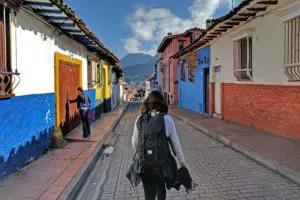
What Travel Insurance Covers & How To Choose The Best One

7 Cheap and Easy Meals for Travellers

5 Things I Really Hate About Air Travel

The Best Debit Card for Australian Travellers – Save Loads of Money
See all our expert Hints & Tips
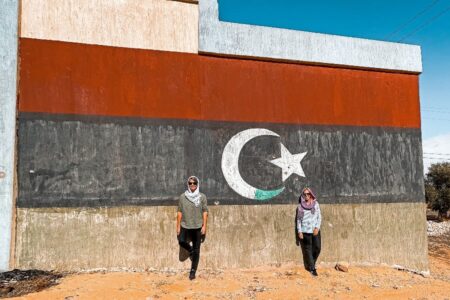
Visiting Libya – One Of The Least Visited Countries
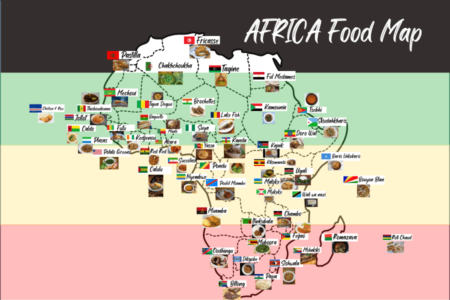
AFRICA Food Map – African Food Guide to 54 Countries
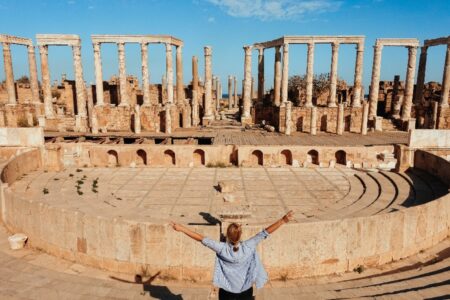
Leptis Magna – 6 INCREDIBLE Places Not to Miss
3 comments . leave new.
Great blog!
Looking to plan a trip to Libya and wondering what is the ideal amount of time to spend in Libya? Is it possible to travel the Ghadames?
Thank you, Karen. Yes, it might be possible to travel to Ghadames. Get in touch with one of the travel agencies to find out if they could organise a trip there as it depends on the current situation. You might need 5 days to see everything in Libya that is currently accessible for visitors.
I would like to visit Libya, if possible for me to go there.
Leave a Reply Cancel reply
Your email address will not be published. Required fields are marked *
Post Comment

IMAGES
VIDEO
COMMENTS
Tourism in Libya is an industry heavily hit by the Libyan Civil War. Before the war tourism was developing, with 149,000 tourists visiting Libya in 2004, rising to 180,000 in 2007, although this still only contributed less than 1% of the country's GDP. There were 1,000,000 day visitors in the same year. [1] [2] The country is best known for its ...
In 2003, the government established the Tourism Development Bank, 80% financed by the private sector. By 2005, over US$3 billion had been attracted for new tourism developments scheduled to provide more than 13,000 new hotel beds (European ... Libya's tourism presence remains very minor, although it has considerable scope for expansion.
LIBYA'S TOURISM INDUSTRY Atiya Abuharris and Les Ruddock Research Institute for the Built and Human Environment, University of Salford Manchester, M7 9NU UK E-mail: [email protected] ABSTRACT: Tourism is one of the fastest growing industries in the world. It has been
Ellabbar, K and Havard, T (2005) The accounting disclosure in developing countries: a comparative study of Libyan & Egyptian construction companies. In: Khosrowshahi, F (Ed ... analysis for Libya as a tourist destination and development proposals for the essential prerequisites needed for the development of the Libya's tourism resources will ...
Libya unveils bold ecotourism project. By Elisabeth Rosenthal. Sept. 10, 2007. CYRENE, Libya — Here in this remote eastern region of Libya whose bleak hills resemble a lunar landscape, the Green ...
Recently Libya has decided to develop the tourism sector to enhance the national economy, which for so many years has been bolstered by the ... Environmental Management, 15(4), pp. 519-29. Wall, G (2005) The Role of Tourism in Sustainable Development, Paper presented at the International Conference on Tourism Development: Tourism Vehicle For ...
Tourism jumped after international sanctions were lifted from Libya in 2003 — Libya's tourism board reported that visits increased from 125,000 in 2006 and 760,000 in 2008, with average ...
Libya possesses vast supplies of undeveloped land with enormous potential for various sectors' development. Recently Libya has decided to develop the tourism sector to enhance the national economy ...
Libya, tourism. Libya is a Northern African country, with a population of 6.5 million, bordering Egypt to the east, Sudan to the southeast, the Mediterranean Sea to the north, Tunisia and Algeria to the west, and Chad and Niger to the south (Figure 1 ). The Libyan economy displays a clear lack of economic diversification, as the country depends ...
Libya Tourism. Download reference work entry PDF. Libya is a Northern African country, bordering Egypt to the east, Sudan to the southeast, the Mediterranean Sea to the north, Tunisia and Algeria to the west, and Chad and Niger to the south (Fig. 1 ). In total, it covers 1,760,000 km 2 (679,539 mi 2) with a population of 6.8 million.
Abstract The Libyan government emphasises the importance of tourism in economic diversification through its Libyan Tourism Master Plan identifying various initiatives ... Human resource development issues for the hotel sector in Libya: a government perspective. Ahmed Naama, Ahmed Naama. Welsh Centre for Tourism Research, Cardiff School of ...
Africa. Libya is an ancient crossroads of civilizations that bequeathed to the Libyan coast some of the finest Roman and Greek ruins in existence, among them Leptis Magna, Cyrene and Sabratha. Libya also has some of the most beautiful corners of the Sahara Desert, from seas of sand the size of Switzerland and sheltering palm-fringed lakes (the ...
But tourism faltered after the Arab Spring and has been paralyzed by the ensuing Civil War. At the time of writing, tourist visas were not being issued and most tour companies have closed their doors - many guides now work as fixers for war reporters instead. ... Libya's intelligence services and armed groups have detained British nationals ...
Libya ( Arabic: ليبيا, Libiya) is a country in the Maghreb region of North Africa and a part of the Arab world. Although the country is rich in history and culture and has great tourism potential, the country has been in the news for all the wrong reasons since the 1960s. Since the 2010s, the country has been in a state of flux and is ...
View Libya's Libya LY: International Tourism: Expenditures: for Passenger Transport Items from 1995 to 2013 in the chart: ... The data reached an all-time high of 81,000.000 Person in 2005 and a record low of 34,000.000 Person in 2008. LY: International Tourism: Number of Arrivals data remains active status in CEIC and is reported by World Bank
Libya tourism statistics for 2010 was 170,000,000.00, a 6.92% increase from 2009. Libya tourism statistics for 2009 was 159,000,000.00, a 60.61% increase from 2008. Libya tourism statistics for 2008 was 99,000,000.00, a 0% increase from 2007. Libya tourism statistics for 2007 was 99,000,000.00, a 59.43% decline from 2006. Download Historical Data.
Lets explore the best places to visit in Libya: 1. Tripoli. Before the tumult of the civil war and the rising of the Arab spring, Tripoli was a poster boy for North African heritage. Its winding labyrinth of backstreets melded the warmth and colours of the Med with the dusty and historic character of the Sahel.
As mentioned, the only way to travel to Libya is by purchasing a tour, which tends to include all expenses but in any case, here's a summary of the most typical costs: Visa: 60€ (in Madrid embassy, at least) Round trip flight Tunis Tripoli with Libyan Wings: 250€. Meal in a local restaurant: around 25-40 LYD.
The Arch of Marcus Aurelius is a Roman triumphal arch in the old city (Oea,Oayat )Tripoli, Libya🇱🇾 It was built around 165AD to celebrate the victories of the emperor's brother,Lucius Verus who had defeated the Parthian Empire & sacked their capital city,Ctesiphon.#HibaShalabi #tripoli #Libya #oldcity #SaveTheOldCityOfTripoli#libia #Trabulusna #WorldHeritage #CulturalHeritage #UNESCO # ...
Libya then passed to UN administration and achieved independence in 1951. Following a 1969 military coup, Col. Muammar al-QADHAFI assumed leadership and began to espouse his political system at home, which was a combination of socialism and Islam. During the 1970s, QADHAFI used oil revenues to promote his ideology outside Libya, supporting ...
More than 100 000 foreigners visited India for medical treatment in the year 2005. India estimates that medical tourism could bring as much as $2.2 billion per year by 2012. ... British and French besides the so- called traditional visitors from Libya and Algeria . The list of countries currently promoting medical tourism include many others ...
In 2020, the tourism industry contributed around 4.7 billion U.S. dollars to Libya's Gross Domestic Product (GDP). The value decreased by approximately 73 percent compared to the previous year ...
Contact: Ibrahim Usta Email: [email protected], [email protected]. Overseas Customer Service: +46708454361 (WhatsApp) Wadi Smalos Tourism Services. Offers 3-5 days packages to Libya but can also arrange a visit to the desert town of Ghadames. Contact: Abubaker Abusahmen Email: [email protected].